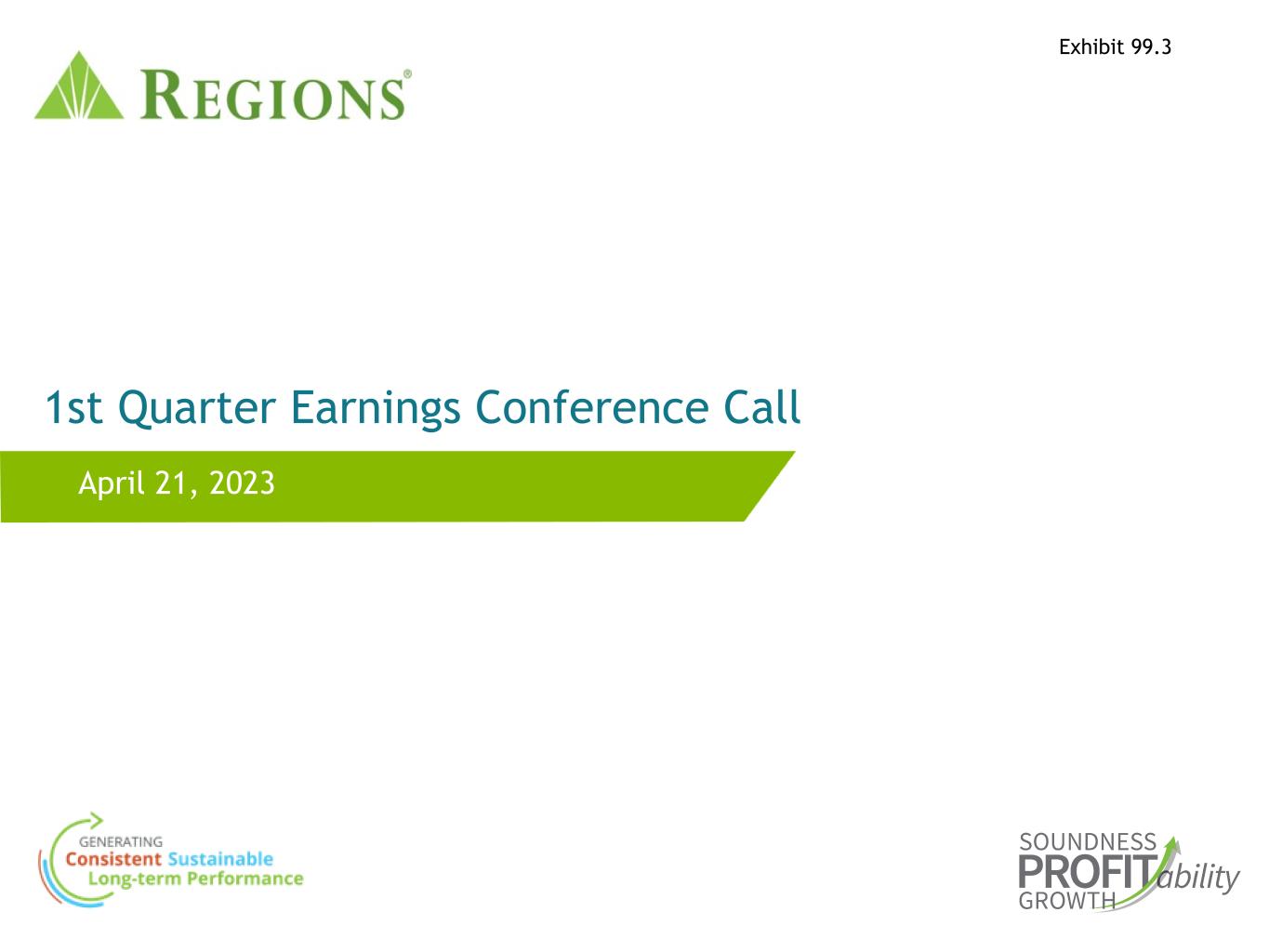
Exhibit 99.3 1st Quarter Earnings Conference Call April 21, 2023
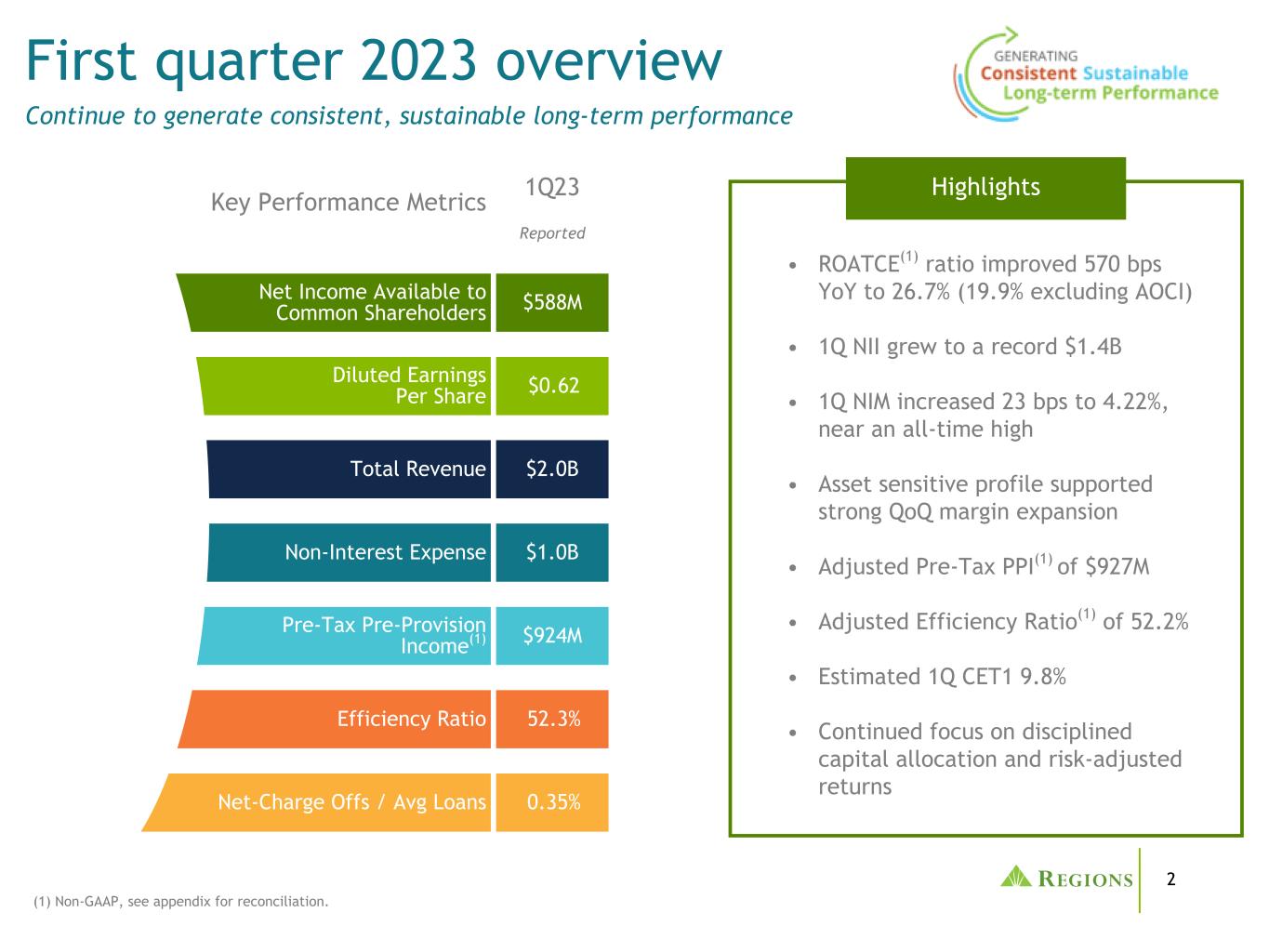
2 First quarter 2023 overview Continue to generate consistent, sustainable long-term performance (1) Non-GAAP, see appendix for reconciliation. Key Performance Metrics 1Q23 Reported Net Income Available to Common Shareholders $588M Diluted Earnings Per Share $0.62 Total Revenue $2.0B Non-Interest Expense $1.0B Pre-Tax Pre-Provision Income(1) $924M Efficiency Ratio 52.3% Net-Charge Offs / Avg Loans 0.35% Highlights • ROATCE(1) ratio improved 570 bps YoY to 26.7% (19.9% excluding AOCI) • 1Q NII grew to a record $1.4B • 1Q NIM increased 23 bps to 4.22%, near an all-time high • Asset sensitive profile supported strong QoQ margin expansion • Adjusted Pre-Tax PPI(1) of $927M • Adjusted Efficiency Ratio(1) of 52.2% • Estimated 1Q CET1 9.8% • Continued focus on disciplined capital allocation and risk-adjusted returns
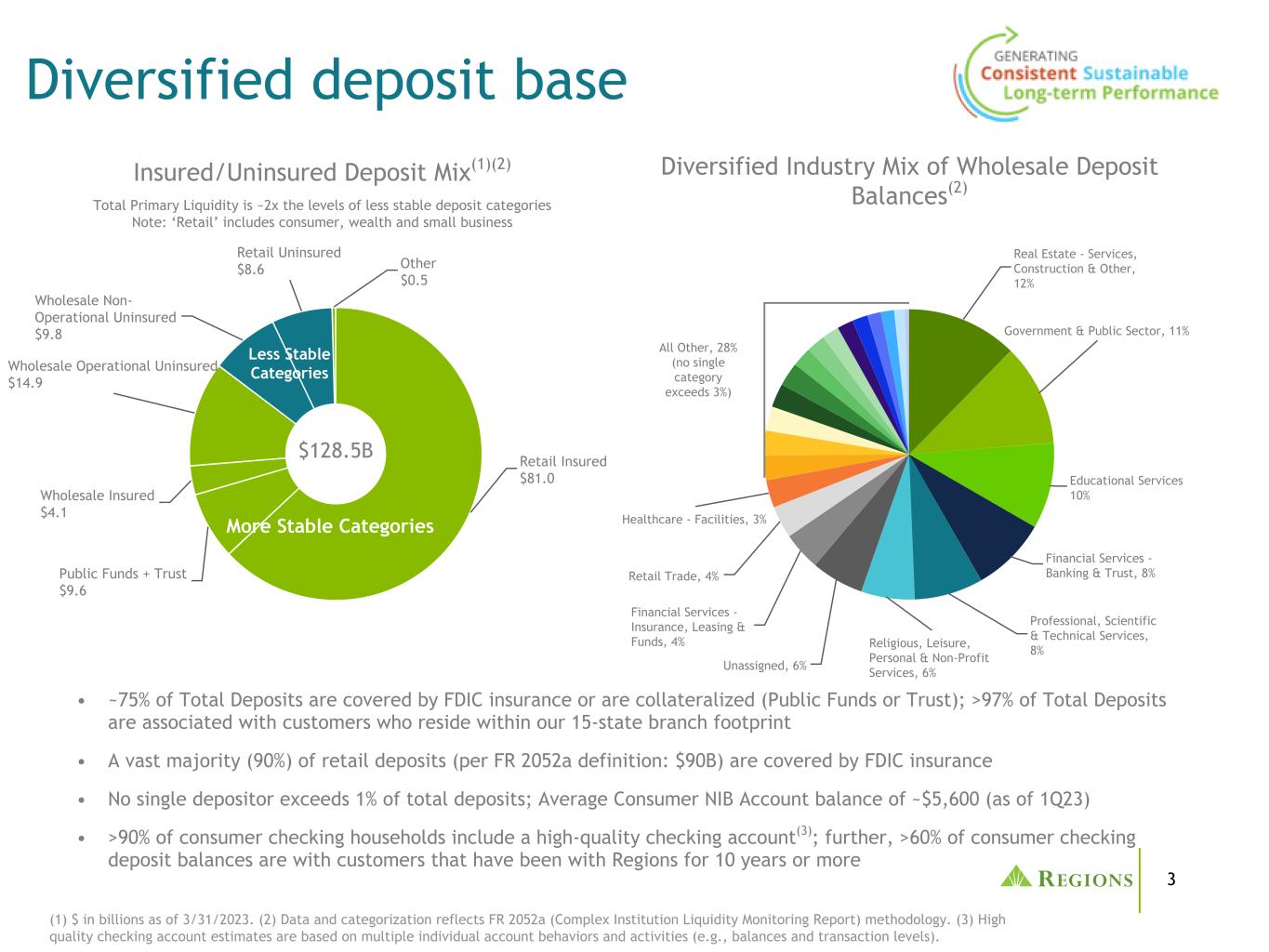
3 Diversified deposit base (1) $ in billions as of 3/31/2023. (2) Data and categorization reflects FR 2052a (Complex Institution Liquidity Monitoring Report) methodology. (3) High quality checking account estimates are based on multiple individual account behaviors and activities (e.g., balances and transaction levels). Diversified Industry Mix of Wholesale Deposit Balances(2) Total Primary Liquidity is ~2x the levels of less stable deposit categories Note: ‘Retail’ includes consumer, wealth and small business Insured/Uninsured Deposit Mix(1)(2) Real Estate - Services, Construction & Other, 12% Government & Public Sector, 11% Educational Services 10% Financial Services - Banking & Trust, 8% Professional, Scientific & Technical Services, 8%Religious, Leisure, Personal & Non-Profit Services, 6%Unassigned, 6% Financial Services - Insurance, Leasing & Funds, 4% Retail Trade, 4% Healthcare - Facilities, 3% All Other, 28% (no single category exceeds 3%) • ~75% of Total Deposits are covered by FDIC insurance or are collateralized (Public Funds or Trust); >97% of Total Deposits are associated with customers who reside within our 15-state branch footprint • A vast majority (90%) of retail deposits (per FR 2052a definition: $90B) are covered by FDIC insurance • No single depositor exceeds 1% of total deposits; Average Consumer NIB Account balance of ~$5,600 (as of 1Q23) • >90% of consumer checking households include a high-quality checking account(3); further, >60% of consumer checking deposit balances are with customers that have been with Regions for 10 years or more Retail Insured $81.0 Public Funds + Trust $9.6 Wholesale Insured $4.1 Wholesale Operational Uninsured $14.9 Wholesale Non- Operational Uninsured $9.8 Retail Uninsured $8.6 Other $0.5 Less Stable Categories More Stable Categories $128.5B
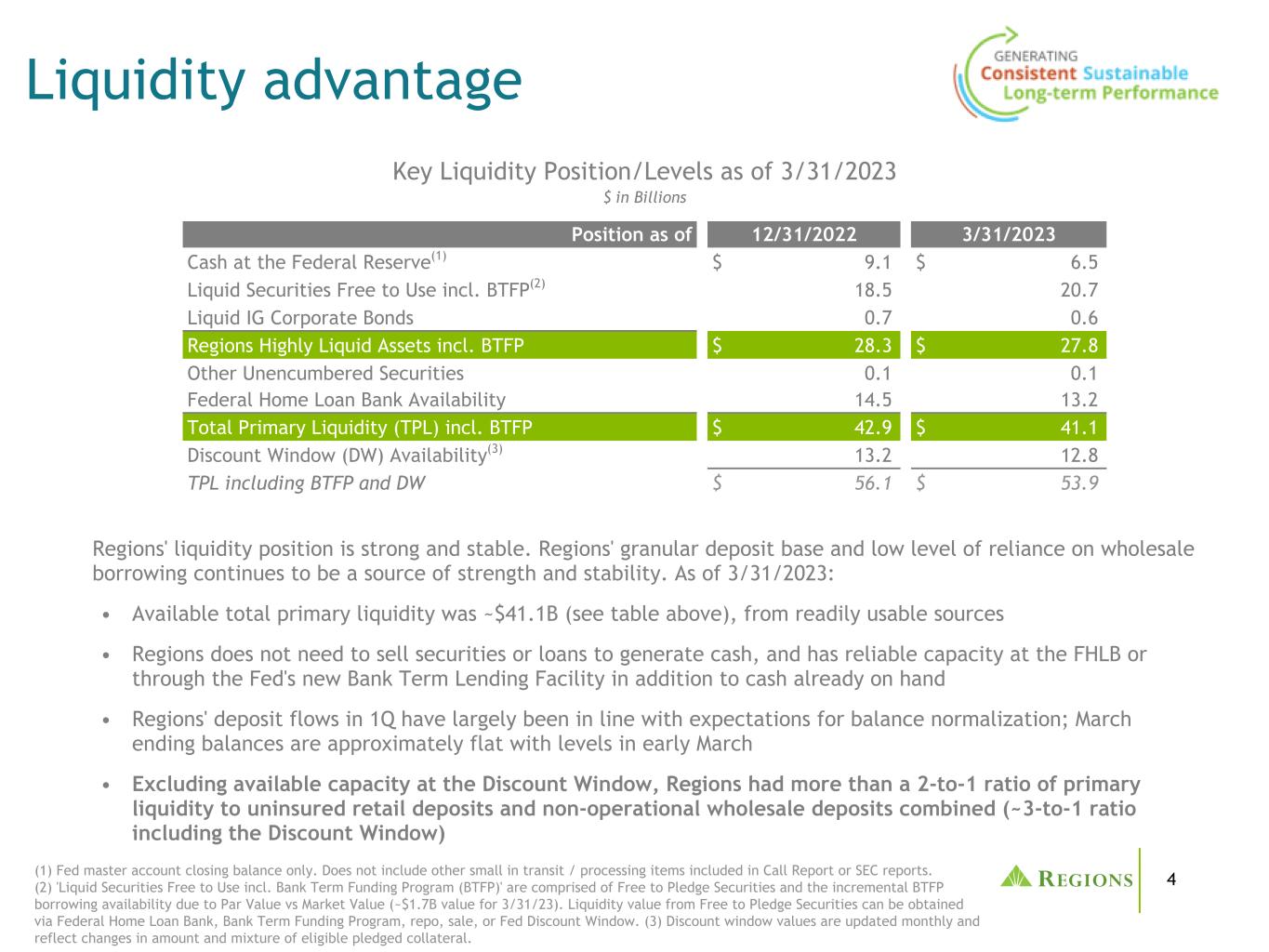
4 Liquidity advantage (1) Fed master account closing balance only. Does not include other small in transit / processing items included in Call Report or SEC reports. (2) 'Liquid Securities Free to Use incl. Bank Term Funding Program (BTFP)' are comprised of Free to Pledge Securities and the incremental BTFP borrowing availability due to Par Value vs Market Value (~$1.7B value for 3/31/23). Liquidity value from Free to Pledge Securities can be obtained via Federal Home Loan Bank, Bank Term Funding Program, repo, sale, or Fed Discount Window. (3) Discount window values are updated monthly and reflect changes in amount and mixture of eligible pledged collateral. Regions' liquidity position is strong and stable. Regions' granular deposit base and low level of reliance on wholesale borrowing continues to be a source of strength and stability. As of 3/31/2023: • Available total primary liquidity was ~$41.1B (see table above), from readily usable sources • Regions does not need to sell securities or loans to generate cash, and has reliable capacity at the FHLB or through the Fed's new Bank Term Lending Facility in addition to cash already on hand • Regions' deposit flows in 1Q have largely been in line with expectations for balance normalization; March ending balances are approximately flat with levels in early March • Excluding available capacity at the Discount Window, Regions had more than a 2-to-1 ratio of primary liquidity to uninsured retail deposits and non-operational wholesale deposits combined (~3-to-1 ratio including the Discount Window) Position as of 12/31/2022 3/31/2023 Cash at the Federal Reserve(1) $ 9.1 $ 6.5 Liquid Securities Free to Use incl. BTFP(2) 18.5 20.7 Liquid IG Corporate Bonds 0.7 0.6 Regions Highly Liquid Assets incl. BTFP $ 28.3 $ 27.8 Other Unencumbered Securities 0.1 0.1 Federal Home Loan Bank Availability 14.5 13.2 Total Primary Liquidity (TPL) incl. BTFP $ 42.9 $ 41.1 Discount Window (DW) Availability(3) 13.2 12.8 TPL including BTFP and DW $ 56.1 $ 53.9 Key Liquidity Position/Levels as of 3/31/2023 $ in Billions
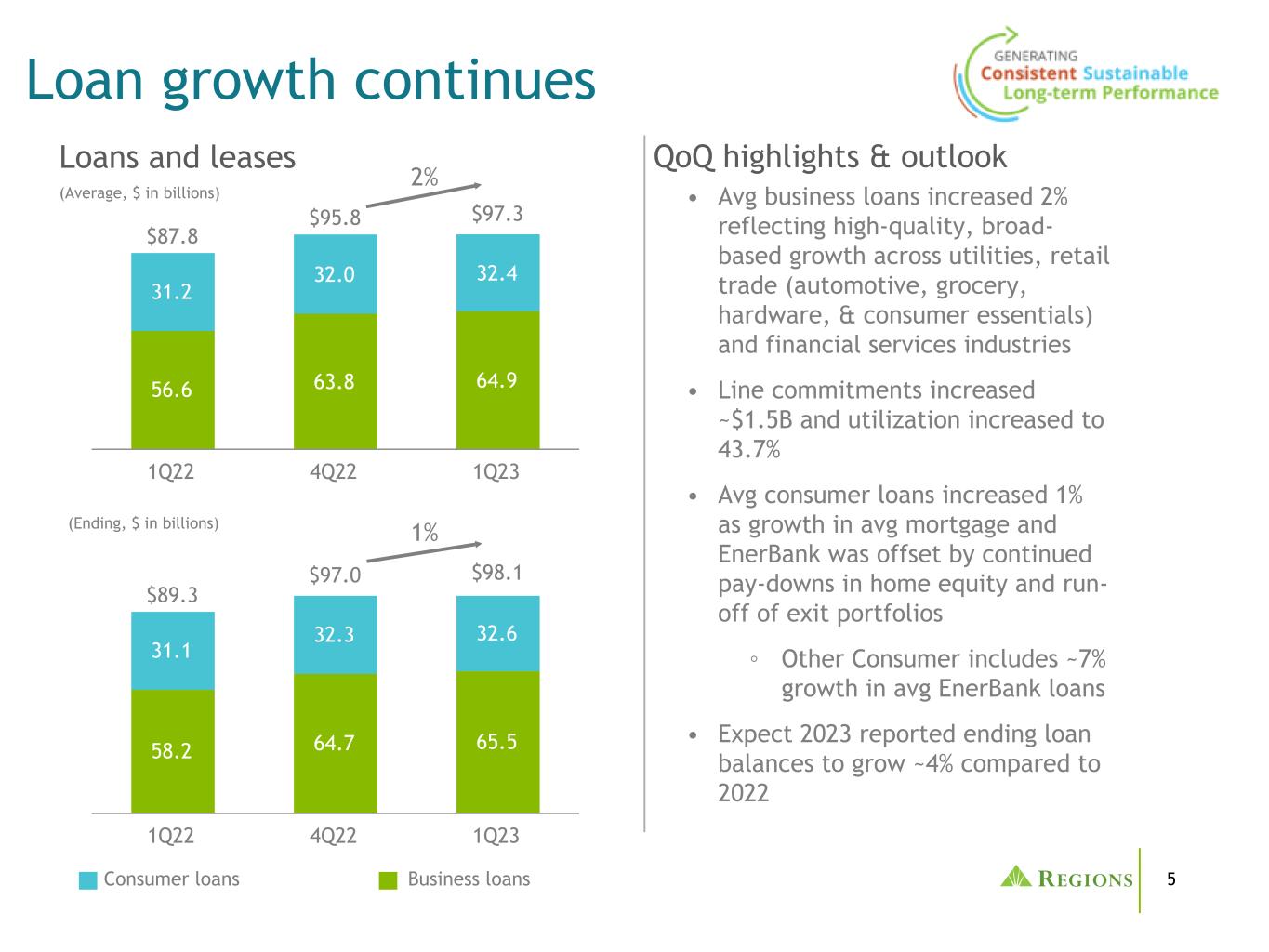
5 • Avg business loans increased 2% reflecting high-quality, broad- based growth across utilities, retail trade (automotive, grocery, hardware, & consumer essentials) and financial services industries • Line commitments increased ~$1.5B and utilization increased to 43.7% • Avg consumer loans increased 1% as growth in avg mortgage and EnerBank was offset by continued pay-downs in home equity and run- off of exit portfolios ◦ Other Consumer includes ~7% growth in avg EnerBank loans • Expect 2023 reported ending loan balances to grow ~4% compared to 2022 Loan growth continues $89.3 $97.0 $98.1 58.2 64.7 65.5 31.1 32.3 32.6 1Q22 4Q22 1Q23 (Ending, $ in billions) $87.8 $95.8 $97.3 56.6 63.8 64.9 31.2 32.0 32.4 1Q22 4Q22 1Q23 Loans and leases (Average, $ in billions) Business loansConsumer loans 2% 1% QoQ highlights & outlook

6 $141.0 $131.7 $128.5 85.2 83.5 83.3 42.8 37.1 35.2 10.4 9.1 8.0 2.6 2.0 2.0 1Q22 4Q22 1Q23 $138.7 $133.0 $129.0 83.1 83.6 82.2 42.6 38.2 36.3 10.4 9.0 8.4 2.6 2.2 2.1 1Q22 4Q22 1Q23 Deposits Normalization occurring as expected (1) Other deposits represent non-customer balances primarily consisting of EnerBank brokered deposits. Wealth Mgt Other(1) Consumer Bank Corporate Bank QoQ highlights & outlook • Deposit base remains a source of strength, balances continue to perform as expected • ~$2B of $3B 1Q ending outflow from corporate deposits reflecting normal seasonal activity; remaining outflow reflects continuation of rate-seeking behavior among certain Wealth and higher balance Consumer clients • Importantly - 3/31 total deposits are roughly unchanged from early March levels; the onset of liquidity concerns in the industry • Ending total deposits expected to decline $3-5B over 1H23, trending towards higher end of range; 2H23 expected to be stable/ modest growth • Focus on attracting and retaining a diverse and granular deposit base with high primacy, which drives loyalty & trust and instills funding stability (Ending, $ in billions) Deposits by Segment (Average, $ in billions)
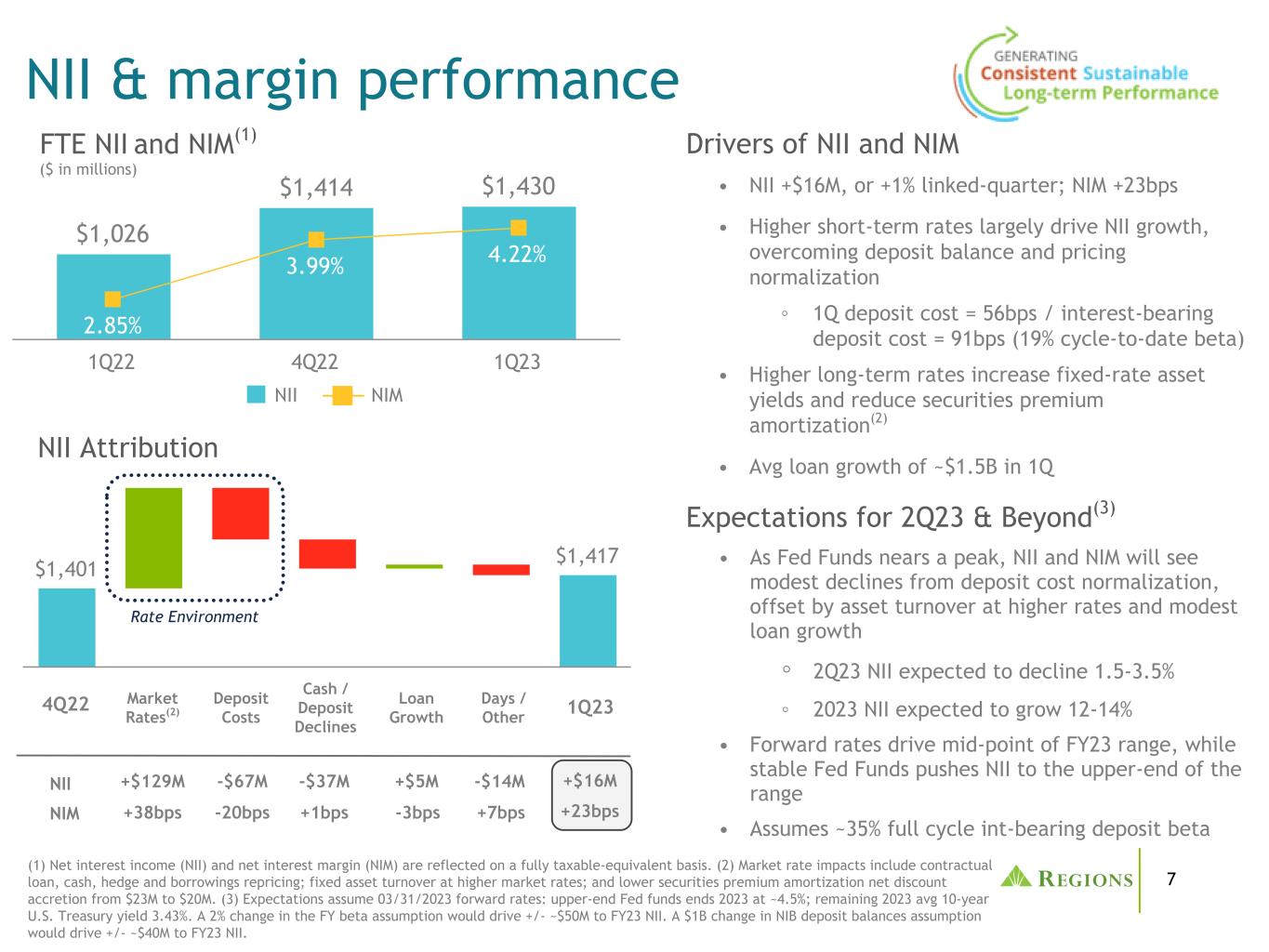
7 Market Rates(2) (1) Net interest income (NII) and net interest margin (NIM) are reflected on a fully taxable-equivalent basis. (2) Market rate impacts include contractual loan, cash, hedge and borrowings repricing; fixed asset turnover at higher market rates; and lower securities premium amortization net discount accretion from $23M to $20M. (3) Expectations assume 03/31/2023 forward rates: upper-end Fed funds ends 2023 at ~4.5%; remaining 2023 avg 10-year U.S. Treasury yield 3.43%. A 2% change in the FY beta assumption would drive +/- ~$50M to FY23 NII. A $1B change in NIB deposit balances assumption would drive +/- ~$40M to FY23 NII. $1,401 $1,417 NII Attribution 1Q23 • NII +$16M, or +1% linked-quarter; NIM +23bps • Higher short-term rates largely drive NII growth, overcoming deposit balance and pricing normalization ◦ 1Q deposit cost = 56bps / interest-bearing deposit cost = 91bps (19% cycle-to-date beta) • Higher long-term rates increase fixed-rate asset yields and reduce securities premium amortization(2) • Avg loan growth of ~$1.5B in 1Q Drivers of NII and NIM 4Q22 -20bps -3bps +7bps+38bps -$67M +$5M -$14M+$129MNII NIM NII & margin performance Days / Other -$37M +1bps Rate Environment $1,026 $1,414 $1,430 2.85% 3.99% 4.22% 1Q22 4Q22 1Q23 Expectations for 2Q23 & Beyond(3) • As Fed Funds nears a peak, NII and NIM will see modest declines from deposit cost normalization, offset by asset turnover at higher rates and modest loan growth ◦ 2Q23 NII expected to decline 1.5-3.5% ◦ 2023 NII expected to grow 12-14% • Forward rates drive mid-point of FY23 range, while stable Fed Funds pushes NII to the upper-end of the range • Assumes ~35% full cycle int-bearing deposit beta NII FTE NII and NIM(1) ($ in millions) NIM Deposit Costs Cash / Deposit Declines Loan Growth +$16M +23bps
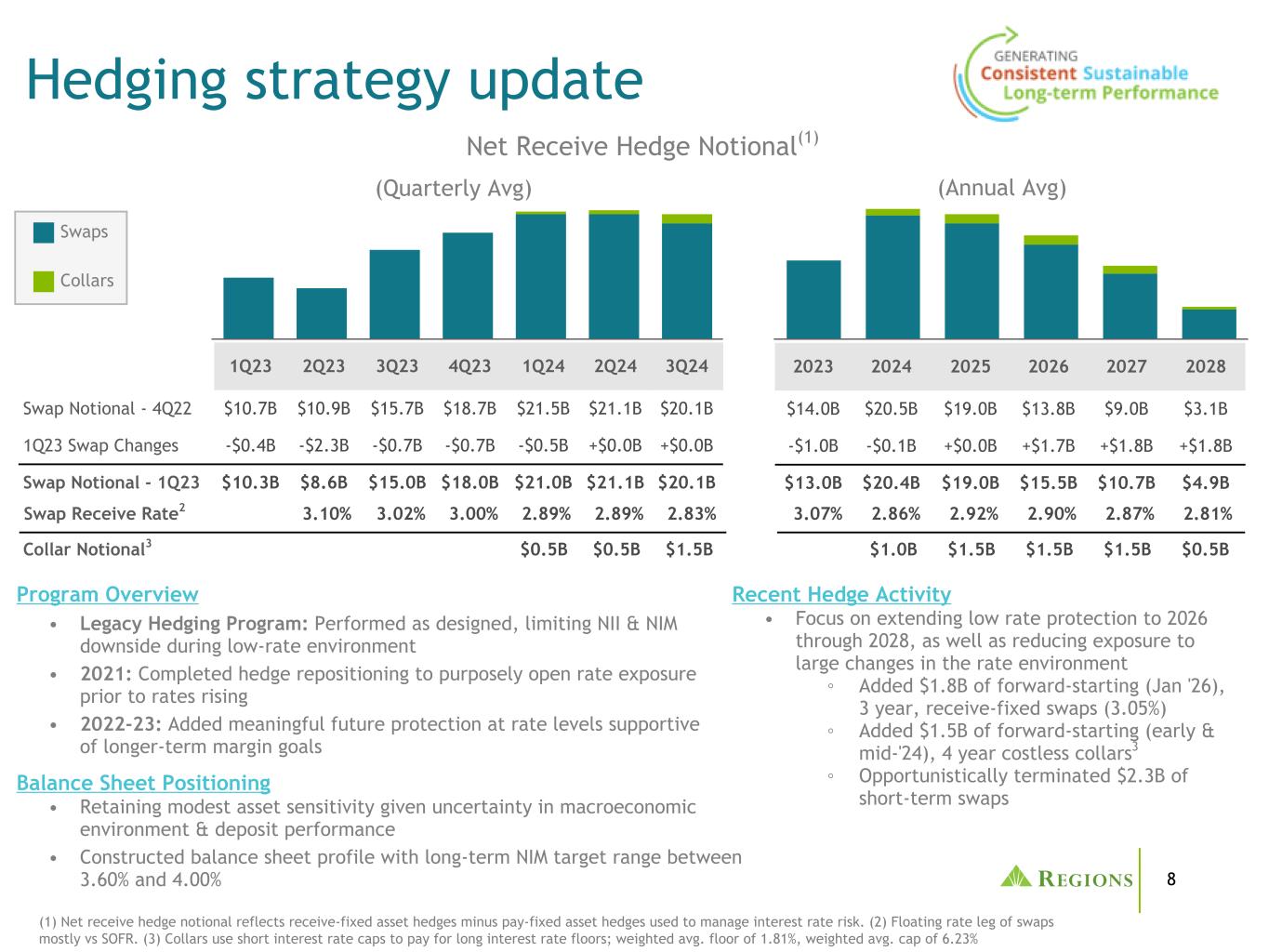
8 1 2 3 4 5 6 7 Program Overview • Legacy Hedging Program: Performed as designed, limiting NII & NIM downside during low-rate environment • 2021: Completed hedge repositioning to purposely open rate exposure prior to rates rising • 2022-23: Added meaningful future protection at rate levels supportive of longer-term margin goals Net Receive Hedge Notional(1) (1) Net receive hedge notional reflects receive-fixed asset hedges minus pay-fixed asset hedges used to manage interest rate risk. (2) Floating rate leg of swaps mostly vs SOFR. (3) Collars use short interest rate caps to pay for long interest rate floors; weighted avg. floor of 1.81%, weighted avg. cap of 6.23% Hedging strategy update (Quarterly Avg) 1 2 3 4 5 62023 2024 2025 2026 2027 2028 $14.0B $20.5B $19.0B $13.8B $9.0B $3.1B -$1.0B -$0.1B +$0.0B +$1.7B +$1.8B +$1.8B $13.0B $20.4B $19.0B $15.5B $10.7B $4.9B 3.07% 2.86% 2.92% 2.90% 2.87% 2.81% (Annual Avg) Recent Hedge Activity • Focus on extending low rate protection to 2026 through 2028, as well as reducing exposure to large changes in the rate environment ◦ Added $1.8B of forward-starting (Jan '26), 3 year, receive-fixed swaps (3.05%) ◦ Added $1.5B of forward-starting (early & mid-'24), 4 year costless collars3 ◦ Opportunistically terminated $2.3B of short-term swaps 1Q23 2Q23 3Q23 4Q23 1Q24 2Q24 3Q24 Swap Notional - 4Q22 $10.7B $10.9B $15.7B $18.7B $21.5B $21.1B $20.1B 1Q23 Swap Changes -$0.4B -$2.3B -$0.7B -$0.7B -$0.5B +$0.0B +$0.0B Swap Notional - 1Q23 $10.3B $8.6B $15.0B $18.0B $21.0B $21.1B $20.1B Swaps Swap Receive Rate2 3.10% 3.02% 3.00% 2.89% 2.89% 2.83% Balance Sheet Positioning • Retaining modest asset sensitivity given uncertainty in macroeconomic environment & deposit performance • Constructed balance sheet profile with long-term NIM target range between 3.60% and 4.00% $1.0B $1.5B $1.5B $1.5B $0.5BCollar Notional3 $0.5B $0.5B $1.5B Collars
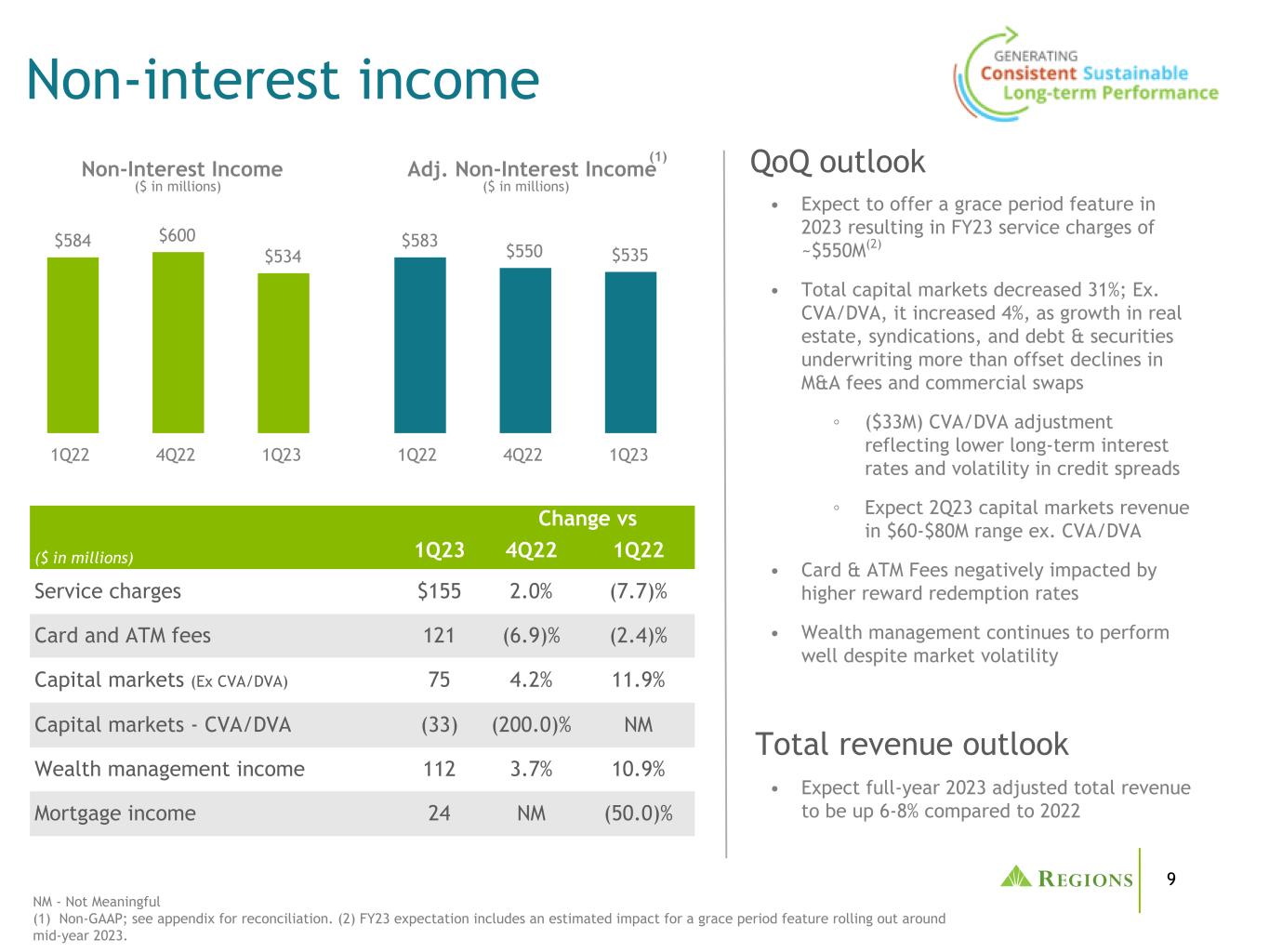
9 Adj. Non-Interest Income $583 $550 $535 1Q22 4Q22 1Q23 Change vs ($ in millions) 1Q23 4Q22 1Q22 Service charges $155 2.0% (7.7)% Card and ATM fees 121 (6.9)% (2.4)% Capital markets (Ex CVA/DVA) 75 4.2% 11.9% Capital markets - CVA/DVA (33) (200.0)% NM Wealth management income 112 3.7% 10.9% Mortgage income 24 NM (50.0)% Non-interest income NM - Not Meaningful (1) Non-GAAP; see appendix for reconciliation. (2) FY23 expectation includes an estimated impact for a grace period feature rolling out around mid-year 2023. • Expect full-year 2023 adjusted total revenue to be up 6-8% compared to 2022 QoQ outlook Total revenue outlook • Expect to offer a grace period feature in 2023 resulting in FY23 service charges of ~$550M(2) • Total capital markets decreased 31%; Ex. CVA/DVA, it increased 4%, as growth in real estate, syndications, and debt & securities underwriting more than offset declines in M&A fees and commercial swaps ◦ ($33M) CVA/DVA adjustment reflecting lower long-term interest rates and volatility in credit spreads ◦ Expect 2Q23 capital markets revenue in $60-$80M range ex. CVA/DVA • Card & ATM Fees negatively impacted by higher reward redemption rates • Wealth management continues to perform well despite market volatility Non-Interest Income $584 $600 $534 1Q22 4Q22 1Q23 ($ in millions) ($ in millions) (1)
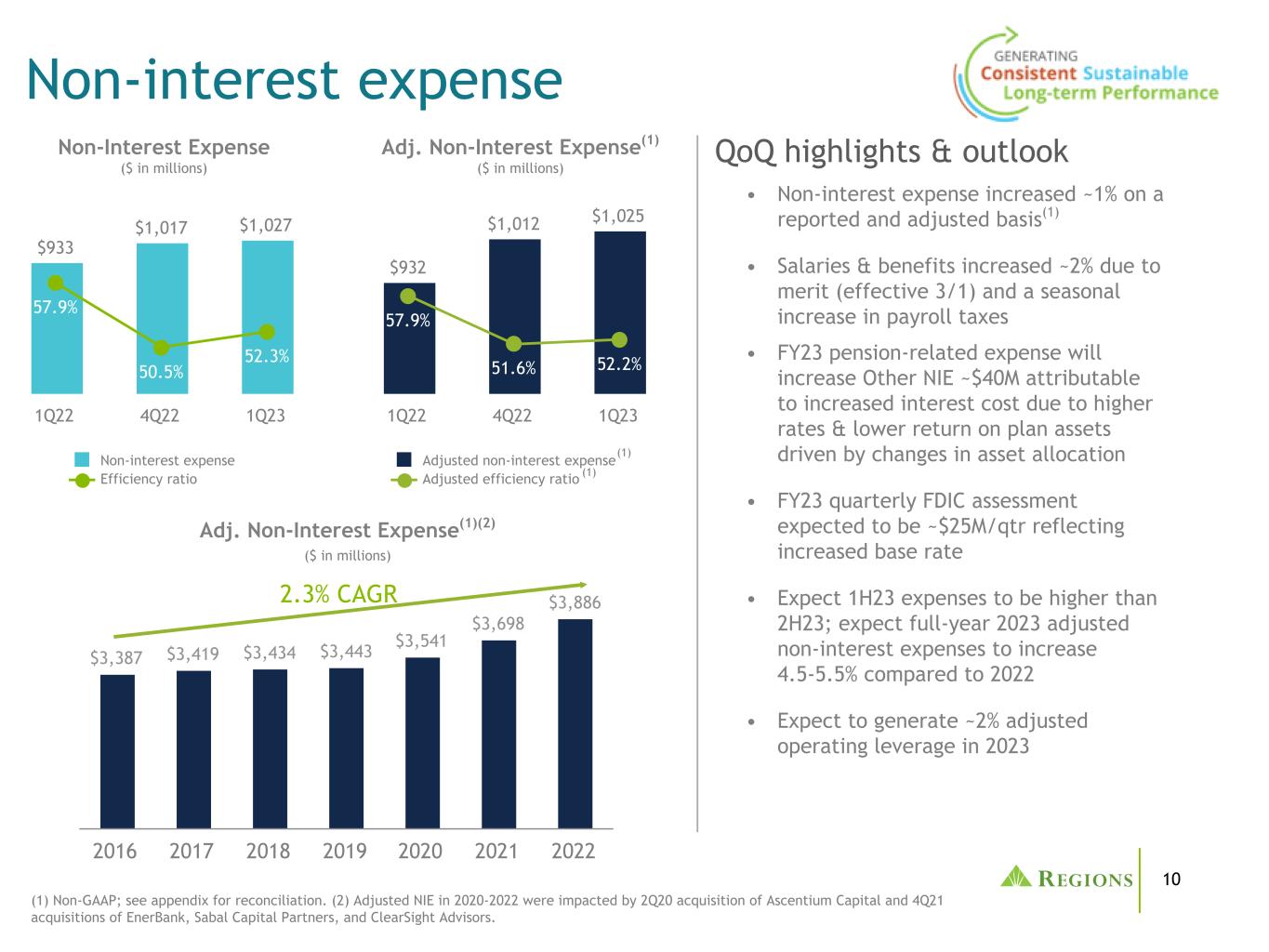
10 $933 $1,017 $1,027 57.9% 50.5% 52.3% Non-interest expense Efficiency ratio 1Q22 4Q22 1Q23 • Non-interest expense increased ~1% on a reported and adjusted basis(1) • Salaries & benefits increased ~2% due to merit (effective 3/1) and a seasonal increase in payroll taxes • FY23 pension-related expense will increase Other NIE ~$40M attributable to increased interest cost due to higher rates & lower return on plan assets driven by changes in asset allocation • FY23 quarterly FDIC assessment expected to be ~$25M/qtr reflecting increased base rate • Expect 1H23 expenses to be higher than 2H23; expect full-year 2023 adjusted non-interest expenses to increase 4.5-5.5% compared to 2022 • Expect to generate ~2% adjusted operating leverage in 2023 $932 $1,012 $1,025 57.9% 51.6% 52.2% Adjusted non-interest expense Adjusted efficiency ratio 1Q22 4Q22 1Q23 $3,387 $3,419 $3,434 $3,443 $3,541 $3,698 $3,886 2016 2017 2018 2019 2020 2021 2022 Non-interest expense QoQ highlights & outlookAdj. Non-Interest Expense(1) ($ in millions) 2.3% CAGR (1) (1) Non-GAAP; see appendix for reconciliation. (2) Adjusted NIE in 2020-2022 were impacted by 2Q20 acquisition of Ascentium Capital and 4Q21 acquisitions of EnerBank, Sabal Capital Partners, and ClearSight Advisors. (1) Non-Interest Expense ($ in millions) Adj. Non-Interest Expense(1)(2) ($ in millions)

11 • Credit performance continues to normalize as expected • 1Q annualized NCOs totaled 35 bps • 1Q NPLs and business services criticized loans increased while total delinquencies decreased • 1Q ACL/Loans ratio remained stable; total ACL increased attributable to economic conditions and normalizing credit, partially offset by reduction associated with the elimination of accounting for TDR loans • Expect full-year 2023 NCOs to be ~35 bps; continuing to trend toward normalized through the cycle range of 35-45 bps over time Non-Performing Loans (NPLs) Asset quality Underlying credit performance continues to normalize as expected ($ in millions) ($ in millions) Allowance for Credit Losses (ACL) $1,492 $1,582 $1,596 1.67% 1.63% 1.63% 446% 317% 288% ACL ACL/Loans ACL/NPLs 1Q22 4Q22 1Q23 0.21% 0.29% 0.35% $335 $500 $554 0.37% 0.52% 0.56% NPLs - excluding LHFS NPL/Loans 1Q22 4Q22 1Q23 Net charge-offs ($ in millions) Net Charge-Offs Net Charge-Offs Ratio
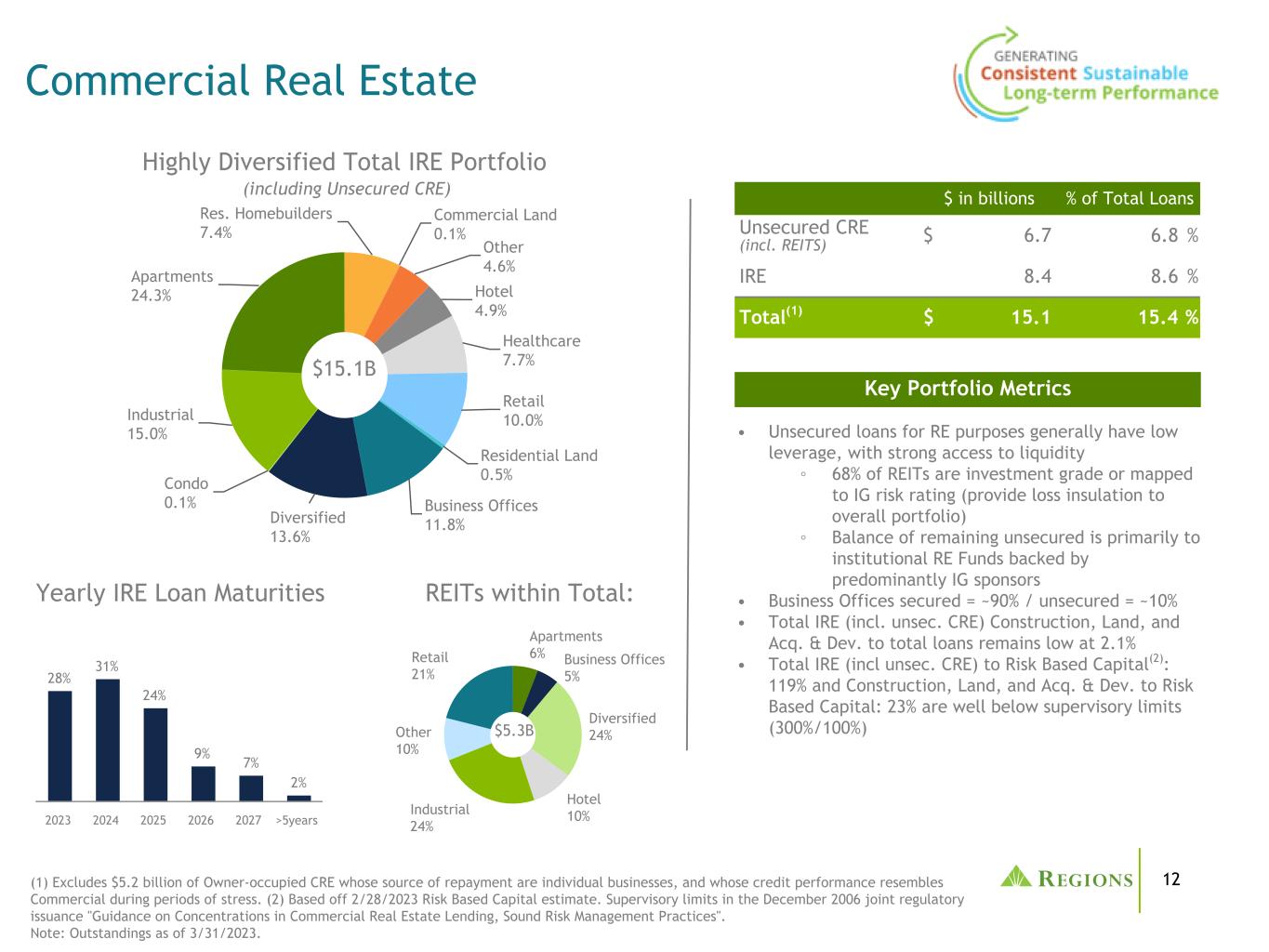
12 Commercial Real Estate Highly Diversified Total IRE Portfolio (including Unsecured CRE) • Unsecured loans for RE purposes generally have low leverage, with strong access to liquidity ◦ 68% of REITs are investment grade or mapped to IG risk rating (provide loss insulation to overall portfolio) ◦ Balance of remaining unsecured is primarily to institutional RE Funds backed by predominantly IG sponsors • Business Offices secured = ~90% / unsecured = ~10% • Total IRE (incl. unsec. CRE) Construction, Land, and Acq. & Dev. to total loans remains low at 2.1% • Total IRE (incl unsec. CRE) to Risk Based Capital(2): 119% and Construction, Land, and Acq. & Dev. to Risk Based Capital: 23% are well below supervisory limits (300%/100%) (1) Excludes $5.2 billion of Owner-occupied CRE whose source of repayment are individual businesses, and whose credit performance resembles Commercial during periods of stress. (2) Based off 2/28/2023 Risk Based Capital estimate. Supervisory limits in the December 2006 joint regulatory issuance "Guidance on Concentrations in Commercial Real Estate Lending, Sound Risk Management Practices". Note: Outstandings as of 3/31/2023. Res. Homebuilders 7.4% Commercial Land 0.1% Other 4.6% Hotel 4.9% Healthcare 7.7% Retail 10.0% Residential Land 0.5% Business Offices 11.8%Diversified 13.6% Condo 0.1% Industrial 15.0% Apartments 24.3% $15.1B $ in billions % of Total Loans Unsecured CRE (incl. REITS) $ 6.7 6.8 % IRE 8.4 8.6 % Total(1) $ 15.1 15.4 % Key Portfolio Metrics Yearly IRE Loan Maturities 28% 31% 24% 9% 7% 2% 2023 2024 2025 2026 2027 >5years Apartments 6% Business Offices 5% Diversified 24% Hotel 10%Industrial 24% Other 10% Retail 21% REITs within Total: $5.3B

13 Higher Risk Industry Segments (Outstanding balances as of March 31, 2023) (1) Amounts exclude PPP loans and Held For Sale loans. (2) GreenStreet Commercial Property Price Index as of April 6, 2023 - change in commercial property value for business office at a 25% discount. Business Services High Risk Segments Portfolio ($ in millions) BAL$(1) % of Total Loans NPL NPL/Loans ACL ACL/Loans Consumer Discretionary Goods Retail Trade & Consumer Manufacturing $2,009 2.0% $15 0.8% $35 1.7% Freight Transportation Transportation & Warehousing 998 1.0% 16 1.6% 36 3.6% Healthcare Goods and Services & Facilities 1,841 1.9% 27 1.4% 63 3.4% Office 1,792 1.8% 51 2.8% 40 2.2% Senior Housing Offices of Physicians & Other Health Practitioners 1,284 1.3% 17 1.4% 41 3.2% Total High Risk Segments $7,924 8.1% $126 1.6% $215 2.7% • Consumer Discretionary Goods: Impacted by rotation away from pandemic driven spending on housing related goods toward food service, travel, and entertainment; Pricing for some goods continue to hold up as input costs fall • Freight Transportation: Concerns limited to smaller trucking firms more likely operating in the spot market; Larger, contract- dependent carriers are better able to manage a downturn in freight markets • Healthcare: Labor availability followed by higher costs continue to impact margins; Medicaid redeterminations began 4/1/23; Uninsured levels could increase by ~4MM pending state-level actions • Senior Housing: Occupancy rate increased for seventh consecutive quarter but remain below pre-pandemic levels Ongoing Portfolio Surveillance • Office: Consists of 83% Class A and 17% Class B in term of secured loan commitments ◦ WA LTV ~58% (based on appraisal at origination or most recent received); Sensitized WA LTV ~77% using GreenStreet(2) ◦ 62% of secured committed exposure is located in the Sunbelt of which 87% is Class A. ◦ 74% of secured committed exposure is in Suburban locations with 26% in Urban ◦ Average property leasing status for maturing office loans is ~89% (~85% Occupancy) ◦ 37% of secured committed exposure is Single-Tenant
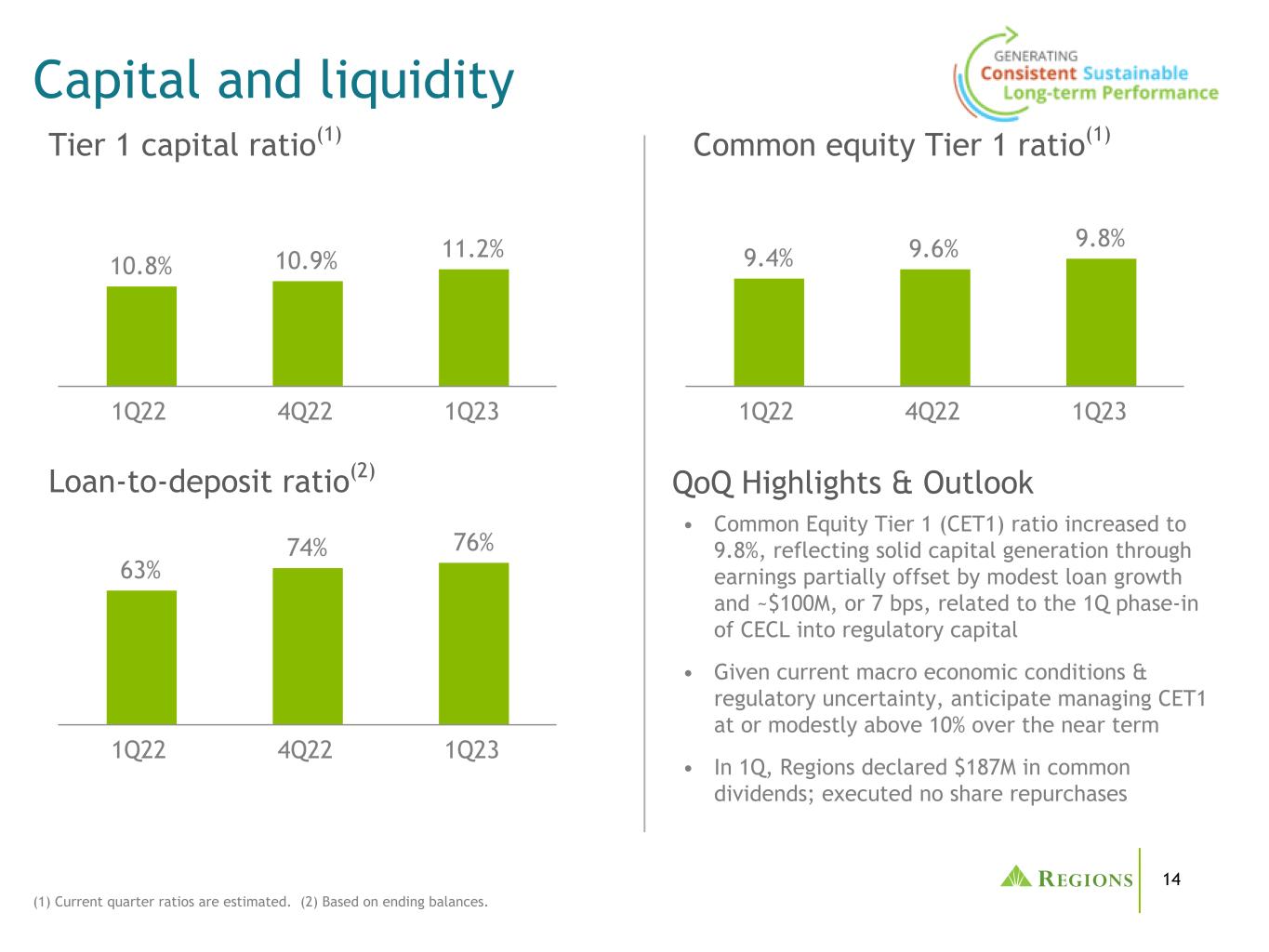
14 9.4% 9.6% 9.8% 1Q22 4Q22 1Q23 • Common Equity Tier 1 (CET1) ratio increased to 9.8%, reflecting solid capital generation through earnings partially offset by modest loan growth and ~$100M, or 7 bps, related to the 1Q phase-in of CECL into regulatory capital • Given current macro economic conditions & regulatory uncertainty, anticipate managing CET1 at or modestly above 10% over the near term • In 1Q, Regions declared $187M in common dividends; executed no share repurchases QoQ Highlights & Outlook Capital and liquidity (1) Current quarter ratios are estimated. (2) Based on ending balances. 10.8% 10.9% 11.2% 1Q22 4Q22 1Q23 Tier 1 capital ratio(1) Loan-to-deposit ratio(2) 63% 74% 76% 1Q22 4Q22 1Q23 Common equity Tier 1 ratio(1)
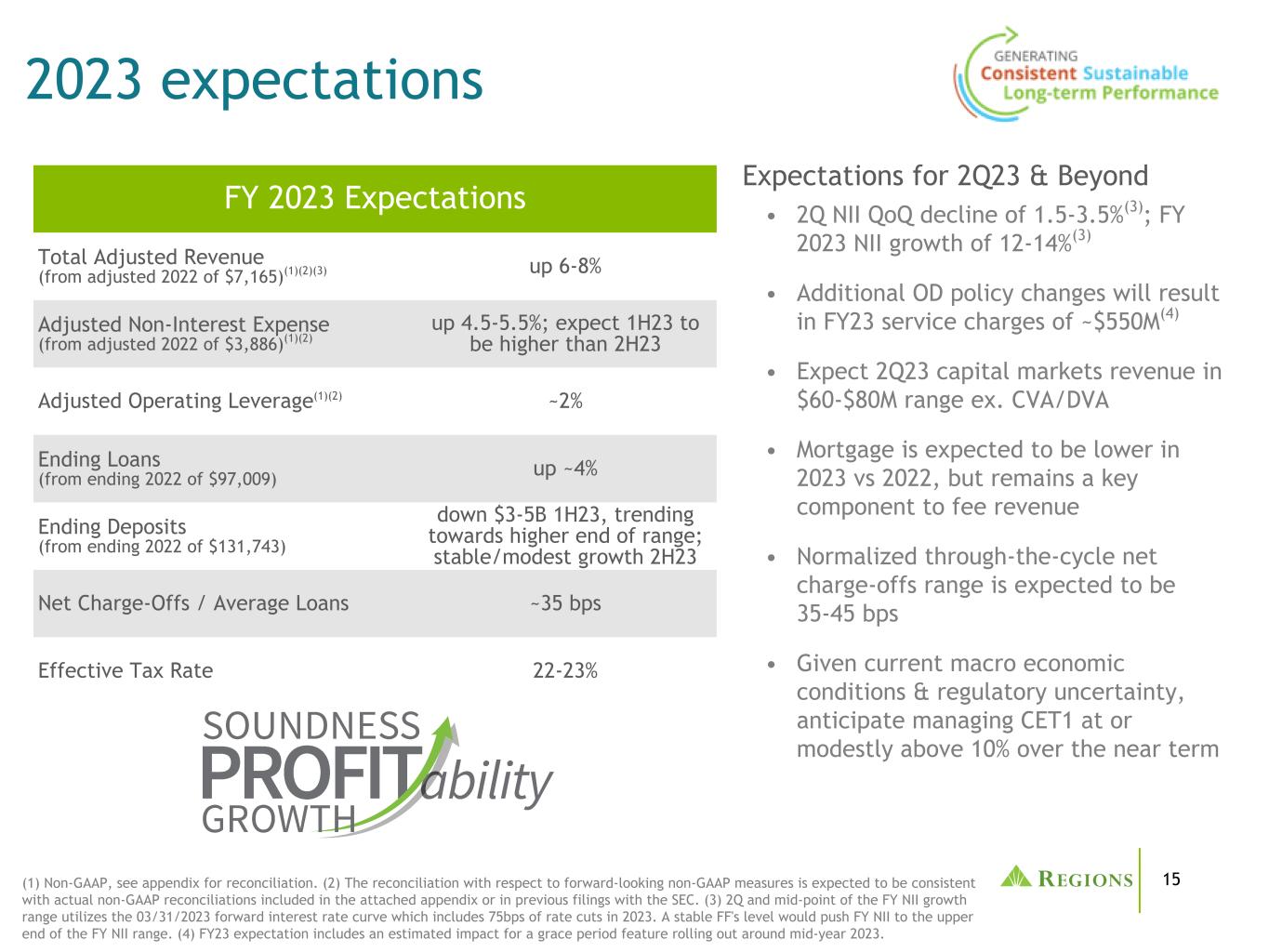
15 2023 expectations (1) Non-GAAP, see appendix for reconciliation. (2) The reconciliation with respect to forward-looking non-GAAP measures is expected to be consistent with actual non-GAAP reconciliations included in the attached appendix or in previous filings with the SEC. (3) 2Q and mid-point of the FY NII growth range utilizes the 03/31/2023 forward interest rate curve which includes 75bps of rate cuts in 2023. A stable FF's level would push FY NII to the upper end of the FY NII range. (4) FY23 expectation includes an estimated impact for a grace period feature rolling out around mid-year 2023. FY 2023 Expectations Total Adjusted Revenue (from adjusted 2022 of $7,165)(1)(2)(3) up 6-8% Adjusted Non-Interest Expense (from adjusted 2022 of $3,886)(1)(2) up 4.5-5.5%; expect 1H23 to be higher than 2H23 Adjusted Operating Leverage(1)(2) ~2% Ending Loans (from ending 2022 of $97,009) up ~4% Ending Deposits (from ending 2022 of $131,743) down $3-5B 1H23, trending towards higher end of range; stable/modest growth 2H23 Net Charge-Offs / Average Loans ~35 bps Effective Tax Rate 22-23% Expectations for 2Q23 & Beyond • 2Q NII QoQ decline of 1.5-3.5%(3); FY 2023 NII growth of 12-14%(3) • Additional OD policy changes will result in FY23 service charges of ~$550M(4) • Expect 2Q23 capital markets revenue in $60-$80M range ex. CVA/DVA • Mortgage is expected to be lower in 2023 vs 2022, but remains a key component to fee revenue • Normalized through-the-cycle net charge-offs range is expected to be 35-45 bps • Given current macro economic conditions & regulatory uncertainty, anticipate managing CET1 at or modestly above 10% over the near term
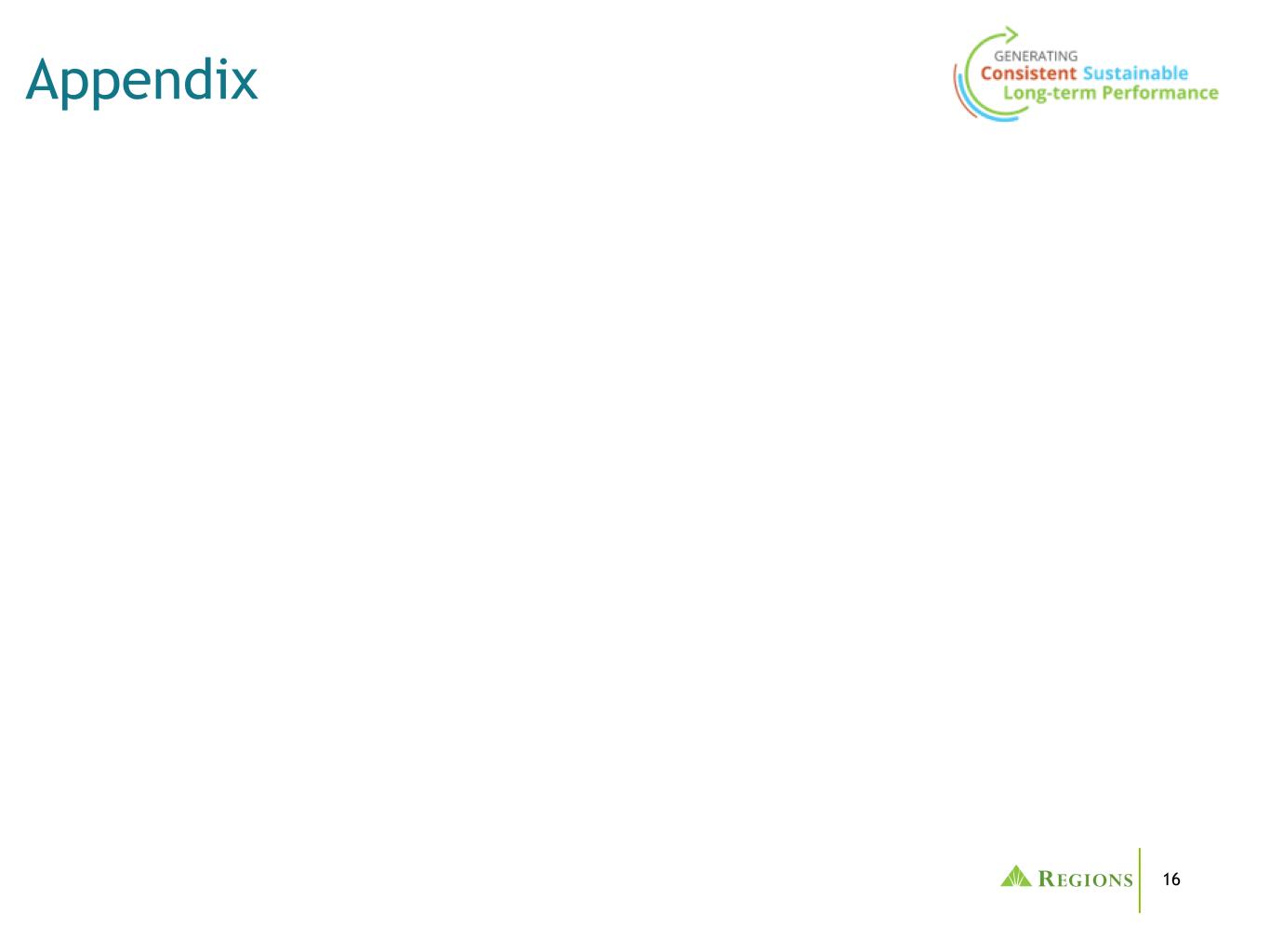
16 Appendix
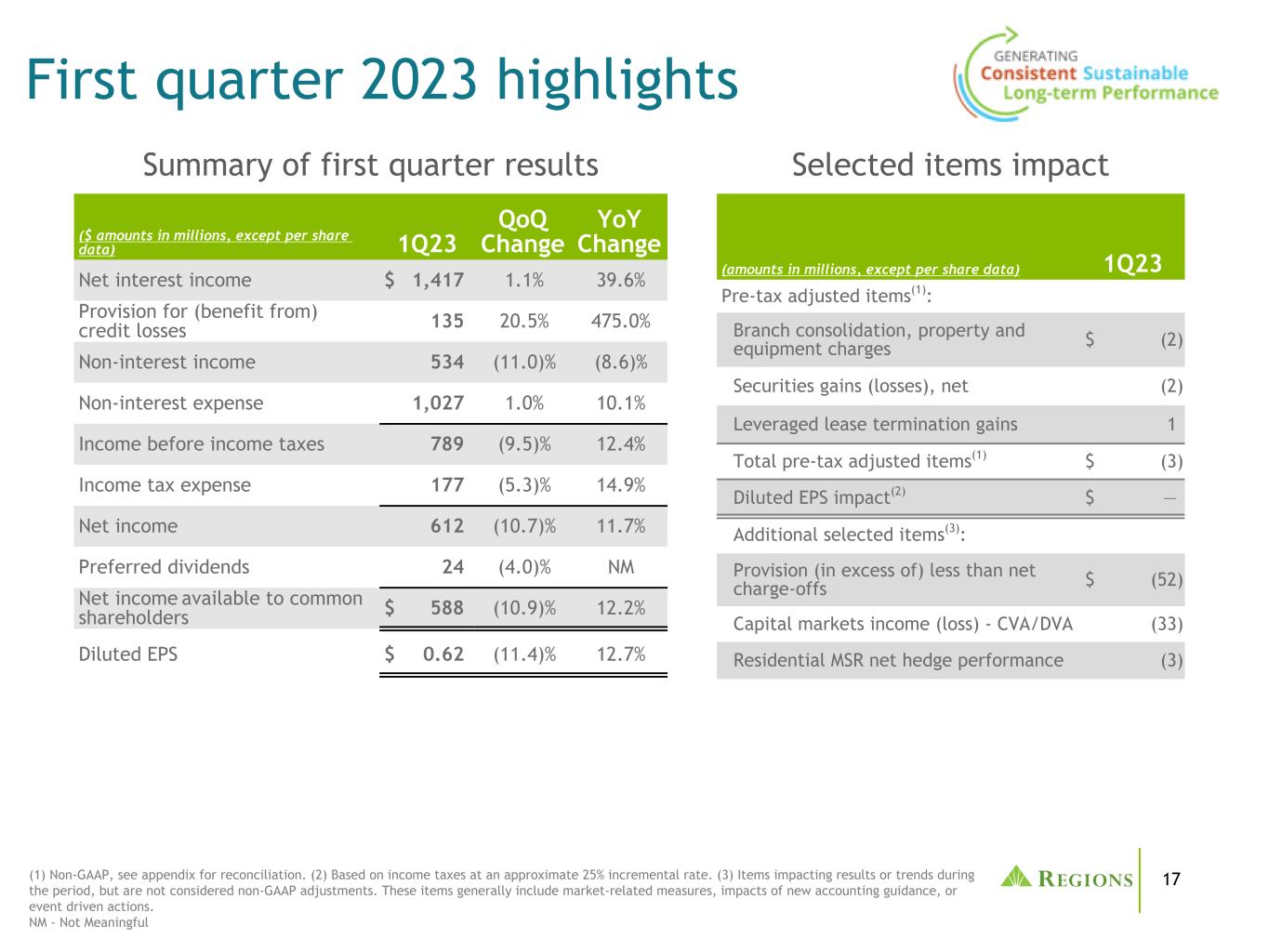
17 Selected items impact First quarter 2023 highlights (1) Non-GAAP, see appendix for reconciliation. (2) Based on income taxes at an approximate 25% incremental rate. (3) Items impacting results or trends during the period, but are not considered non-GAAP adjustments. These items generally include market-related measures, impacts of new accounting guidance, or event driven actions. NM - Not Meaningful ($ amounts in millions, except per share data) 1Q23 QoQ Change YoY Change Net interest income $ 1,417 1.1% 39.6% Provision for (benefit from) credit losses 135 20.5% 475.0% Non-interest income 534 (11.0)% (8.6)% Non-interest expense 1,027 1.0% 10.1% Income before income taxes 789 (9.5)% 12.4% Income tax expense 177 (5.3)% 14.9% Net income 612 (10.7)% 11.7% Preferred dividends 24 (4.0)% NM Net income available to common shareholders $ 588 (10.9)% 12.2% Diluted EPS $ 0.62 (11.4)% 12.7% Summary of first quarter results (amounts in millions, except per share data) 1Q23 Pre-tax adjusted items(1): Branch consolidation, property and equipment charges $ (2) Securities gains (losses), net (2) Leveraged lease termination gains 1 Total pre-tax adjusted items(1) $ (3) Diluted EPS impact(2) $ — Additional selected items(3): Provision (in excess of) less than net charge-offs $ (52) Capital markets income (loss) - CVA/DVA (33) Residential MSR net hedge performance (3)
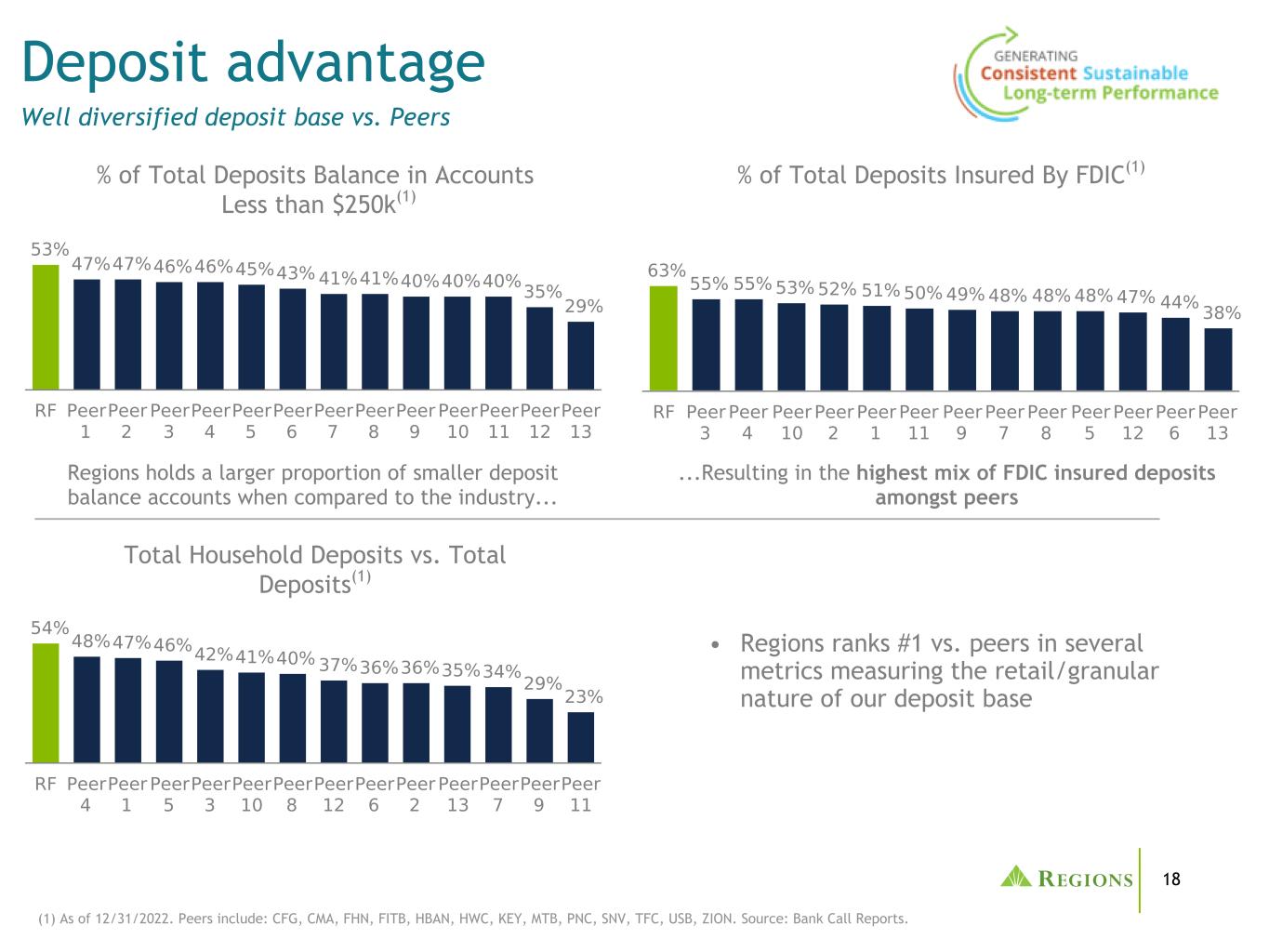
18 Deposit advantage Well diversified deposit base vs. Peers (1) As of 12/31/2022. Peers include: CFG, CMA, FHN, FITB, HBAN, HWC, KEY, MTB, PNC, SNV, TFC, USB, ZION. Source: Bank Call Reports. ...Resulting in the highest mix of FDIC insured deposits amongst peers % of Total Deposits Insured By FDIC(1)% of Total Deposits Balance in Accounts Less than $250k(1) Regions holds a larger proportion of smaller deposit balance accounts when compared to the industry... Total Household Deposits vs. Total Deposits(1) • Regions ranks #1 vs. peers in several metrics measuring the retail/granular nature of our deposit base

19 (1) Feb '22 - Feb '23 (2) Quality Relationships defined as having a cumulative $500K in loans, deposits and IM&T accounts, revenue per Quality Relationship measured over TTM, Feb '23 vs Dec '22. (3) Retention of IM&T revenue vs baseline. Investments in our businesses Investments in talent, technology and strategic acquisitions continue to pay off CORPORATE CONSUMER WEALTH Mobile users increased 6.3% YoY Increase in revenue per quality relationship(2) of 3% Clearsight had its second highest quarter since acquisition with $9M in M&A fee income Wealth Client IQ launched in Institutional Services to capture opportunities and provide key client insights Industry leading Customer Satisfaction and primacy levels Provided Our Best Thinking to clients during recent industry disruption to emphasize stability and security Completed $13B UPB MSRs bulk purchases in 2022 & continue to evaluate MSR purchases on a flow basis Built deeper lead analytics tools for MLOs EnerBank generating high quality loans; synergy work ongoing Investment Services average monthly revenue up 39%, over 1Q22 Launched PWM Client Care Center for enhanced client servicing Streamlined client onboarding process focused on Customer Due Diligence and asset transfer activities contributing Treasury Management client base grew 8.7% YoY(1); Revenue grew 8.2% QoQ Significantly improved closing time on home equity products High quality talent remains interested in Regions given strong reputation & culture Enhanced origination productivity with BUILT & Blooma; Continued expansion of Regions Client IQ (RCLIQ) Small Business remains a focal point: Ascentium Capital loan production is up 15% vs 1Q22; SBA booked loan volume is up 42% vs 1Q22 Continue to grow net consumer checking accounts
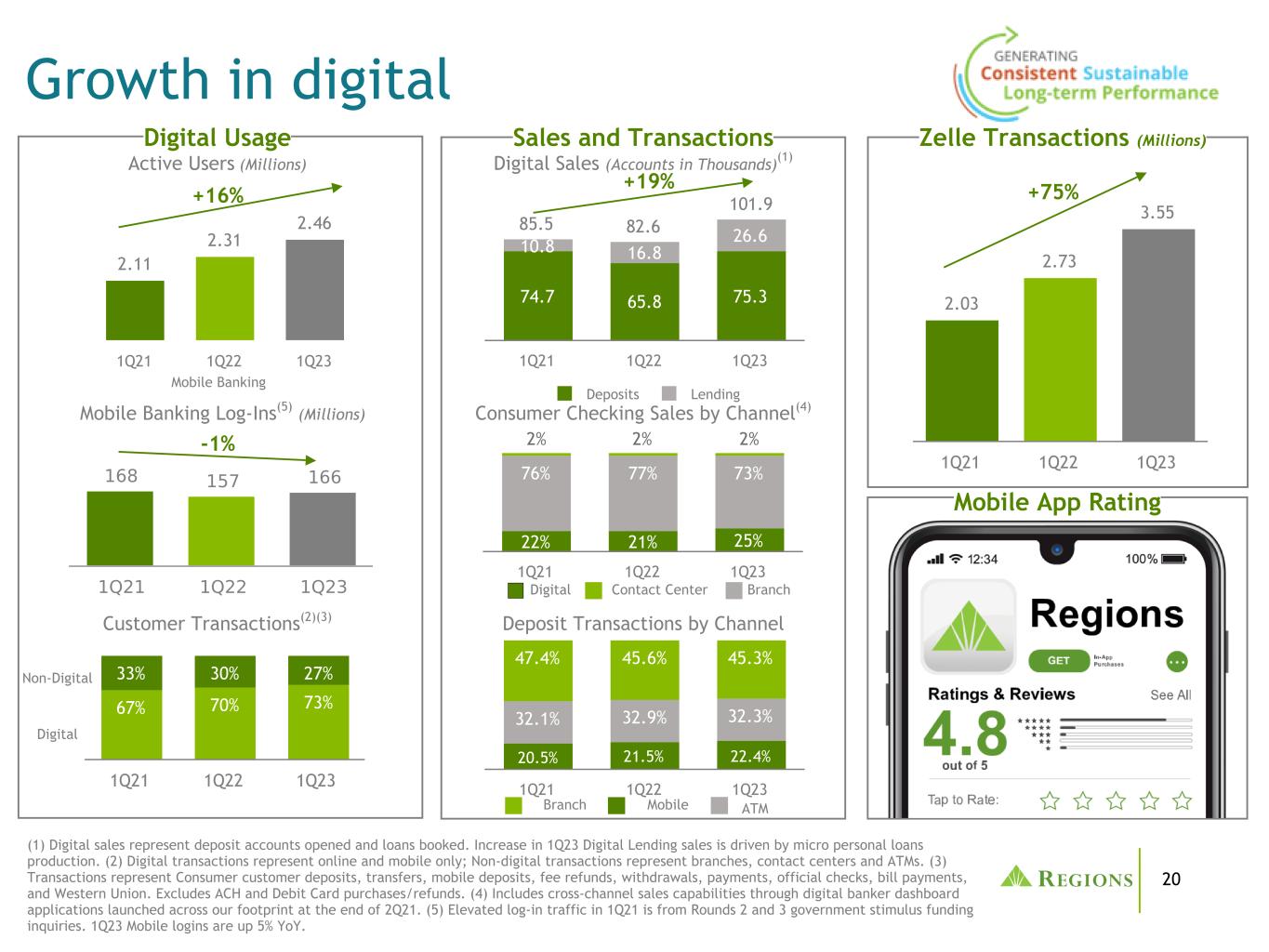
20 2.11 2.31 2.46 1Q21 1Q22 1Q23 2.03 2.73 3.55 1Q21 1Q22 1Q23 20.5% 21.5% 22.4% 32.1% 32.9% 32.3% 47.4% 45.6% 45.3% 1Q21 1Q22 1Q23 85.5 82.6 101.9 74.7 65.8 75.3 10.8 16.8 26.6 Deposits Lending 1Q21 1Q22 1Q23 67% 70% 73% 33% 30% 27% 1Q21 1Q22 1Q23 Growth in digital Mobile Banking Log-Ins(5) (Millions) Customer Transactions(2)(3) Deposit Transactions by Channel Active Users (Millions) Digital Sales (Accounts in Thousands)(1) Digital Non-Digital Mobile ATMBranch (1) Digital sales represent deposit accounts opened and loans booked. Increase in 1Q23 Digital Lending sales is driven by micro personal loans production. (2) Digital transactions represent online and mobile only; Non-digital transactions represent branches, contact centers and ATMs. (3) Transactions represent Consumer customer deposits, transfers, mobile deposits, fee refunds, withdrawals, payments, official checks, bill payments, and Western Union. Excludes ACH and Debit Card purchases/refunds. (4) Includes cross-channel sales capabilities through digital banker dashboard applications launched across our footprint at the end of 2Q21. (5) Elevated log-in traffic in 1Q21 is from Rounds 2 and 3 government stimulus funding inquiries. 1Q23 Mobile logins are up 5% YoY. +75% -1% 22% 21% 25% 76% 77% 73% 2% 2% 2% 1Q21 1Q22 1Q23 Digital BranchContact Center Consumer Checking Sales by Channel(4) Mobile Banking Mobile App Rating Zelle Transactions (Millions)Sales and TransactionsDigital Usage +19% +16%
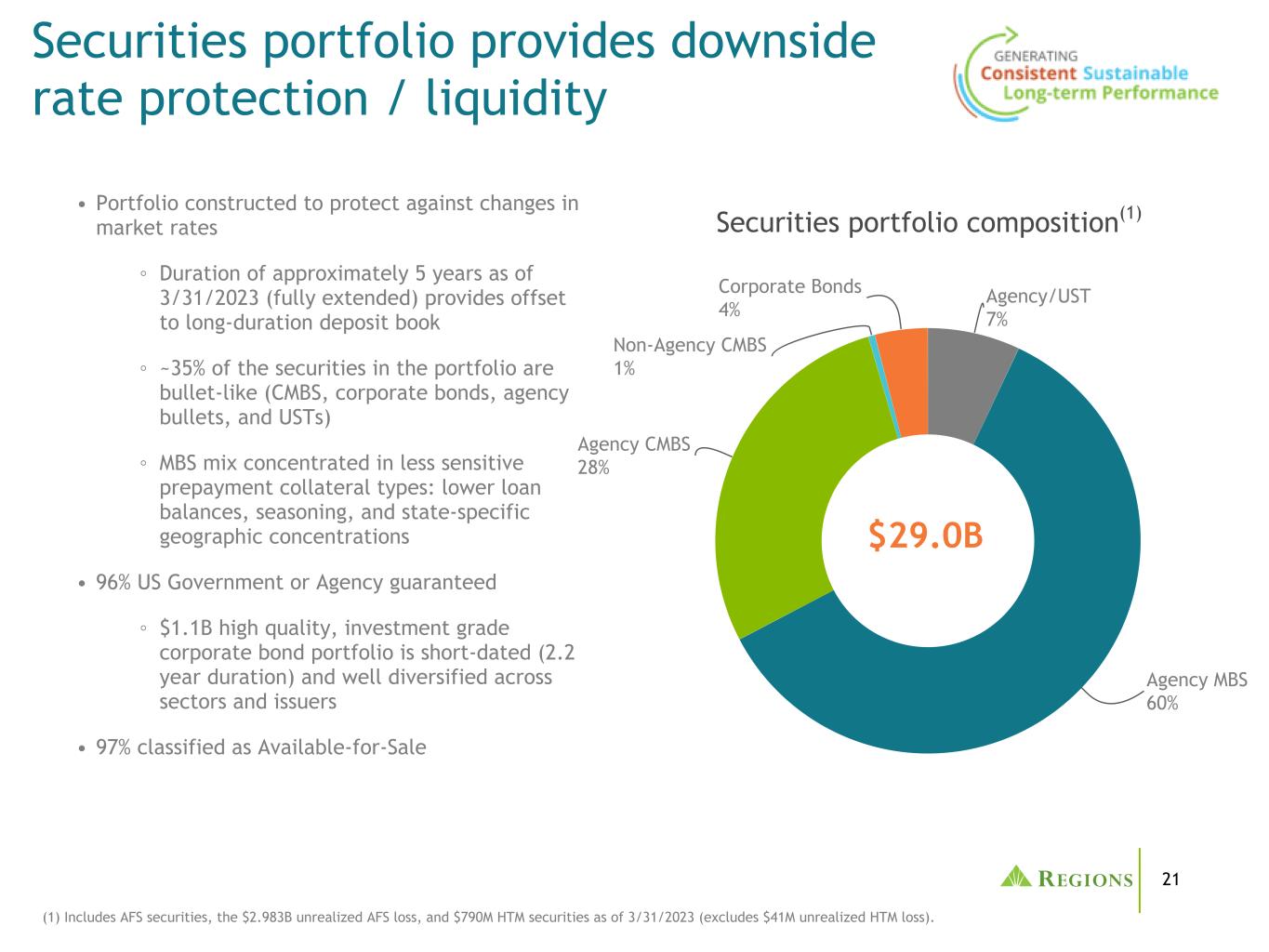
21 • Portfolio constructed to protect against changes in market rates ◦ Duration of approximately 5 years as of 3/31/2023 (fully extended) provides offset to long-duration deposit book ◦ ~35% of the securities in the portfolio are bullet-like (CMBS, corporate bonds, agency bullets, and USTs) ◦ MBS mix concentrated in less sensitive prepayment collateral types: lower loan balances, seasoning, and state-specific geographic concentrations • 96% US Government or Agency guaranteed ◦ $1.1B high quality, investment grade corporate bond portfolio is short-dated (2.2 year duration) and well diversified across sectors and issuers • 97% classified as Available-for-Sale Agency/UST 7% Agency MBS 60% Agency CMBS 28% Non-Agency CMBS 1% Corporate Bonds 4% Securities portfolio provides downside rate protection / liquidity Securities portfolio composition(1) $29.0B (1) Includes AFS securities, the $2.983B unrealized AFS loss, and $790M HTM securities as of 3/31/2023 (excludes $41M unrealized HTM loss).
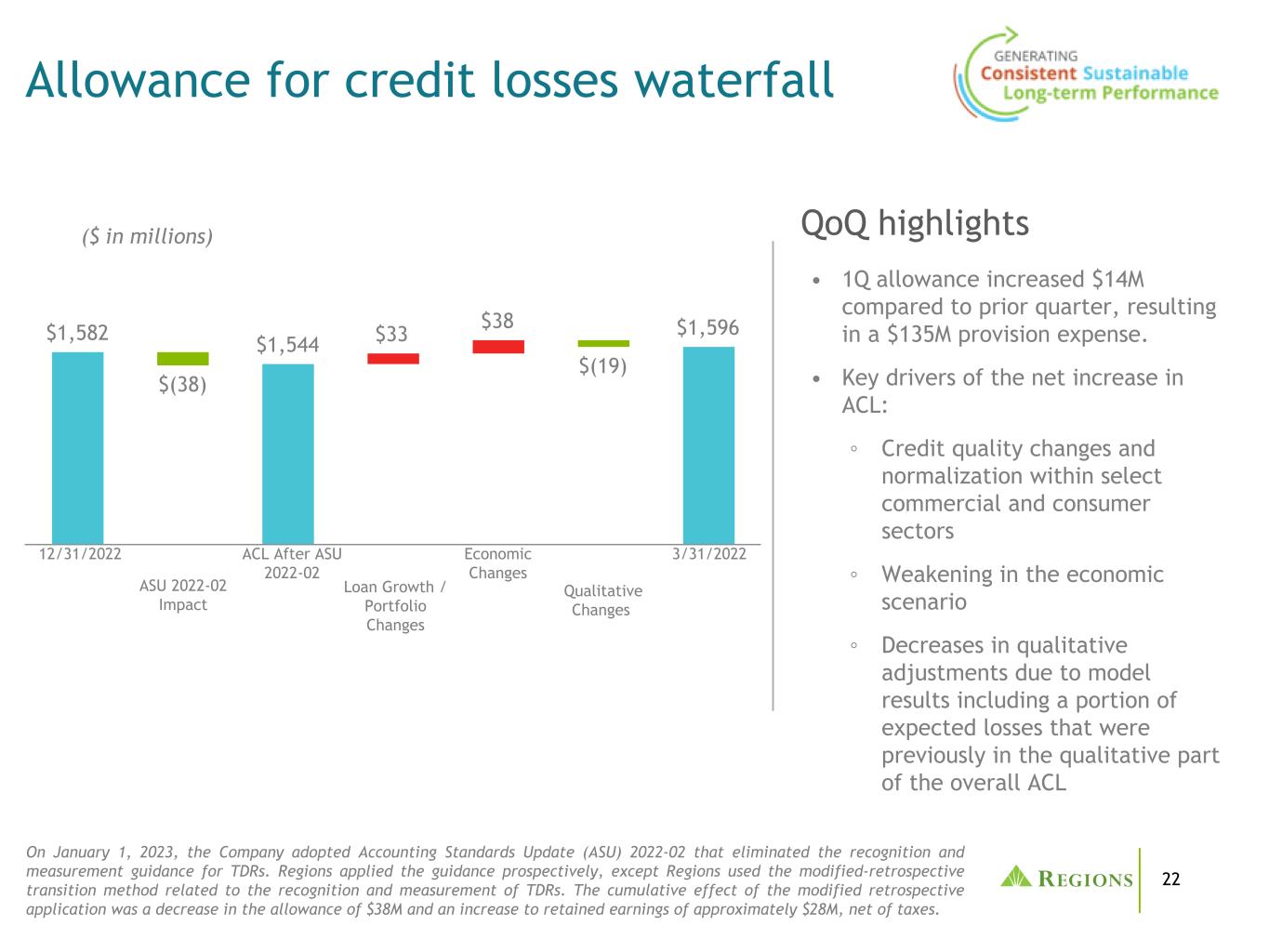
22 ACL After ASU 2022-02 $1,582 $(38) $1,544 $33 $38 $(19) $1,596 Allowance for credit losses waterfall 3/31/2022 • 1Q allowance increased $14M compared to prior quarter, resulting in a $135M provision expense. • Key drivers of the net increase in ACL: ◦ Credit quality changes and normalization within select commercial and consumer sectors ◦ Weakening in the economic scenario ◦ Decreases in qualitative adjustments due to model results including a portion of expected losses that were previously in the qualitative part of the overall ACL QoQ highlights($ in millions) 12/31/2022 ASU 2022-02 Impact Qualitative Changes Loan Growth / Portfolio Changes Economic Changes On January 1, 2023, the Company adopted Accounting Standards Update (ASU) 2022-02 that eliminated the recognition and measurement guidance for TDRs. Regions applied the guidance prospectively, except Regions used the modified-retrospective transition method related to the recognition and measurement of TDRs. The cumulative effect of the modified retrospective application was a decrease in the allowance of $38M and an increase to retained earnings of approximately $28M, net of taxes.
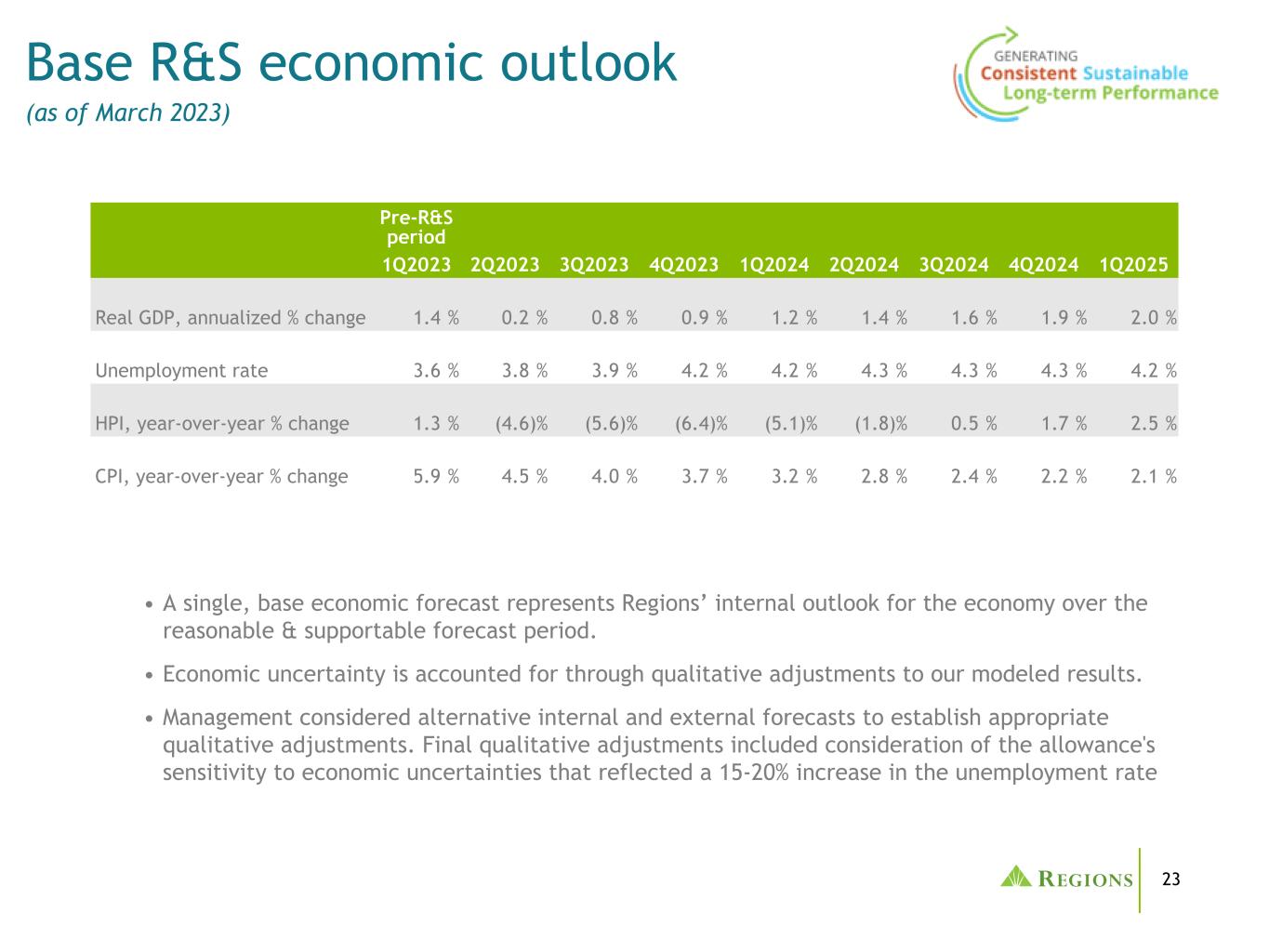
23 Pre-R&S period 1Q2023 2Q2023 3Q2023 4Q2023 1Q2024 2Q2024 3Q2024 4Q2024 1Q2025 Real GDP, annualized % change 1.4 % 0.2 % 0.8 % 0.9 % 1.2 % 1.4 % 1.6 % 1.9 % 2.0 % Unemployment rate 3.6 % 3.8 % 3.9 % 4.2 % 4.2 % 4.3 % 4.3 % 4.3 % 4.2 % HPI, year-over-year % change 1.3 % (4.6) % (5.6) % (6.4) % (5.1) % (1.8) % 0.5 % 1.7 % 2.5 % CPI, year-over-year % change 5.9 % 4.5 % 4.0 % 3.7 % 3.2 % 2.8 % 2.4 % 2.2 % 2.1 % Base R&S economic outlook (as of March 2023) • A single, base economic forecast represents Regions’ internal outlook for the economy over the reasonable & supportable forecast period. • Economic uncertainty is accounted for through qualitative adjustments to our modeled results. • Management considered alternative internal and external forecasts to establish appropriate qualitative adjustments. Final qualitative adjustments included consideration of the allowance's sensitivity to economic uncertainties that reflected a 15-20% increase in the unemployment rate
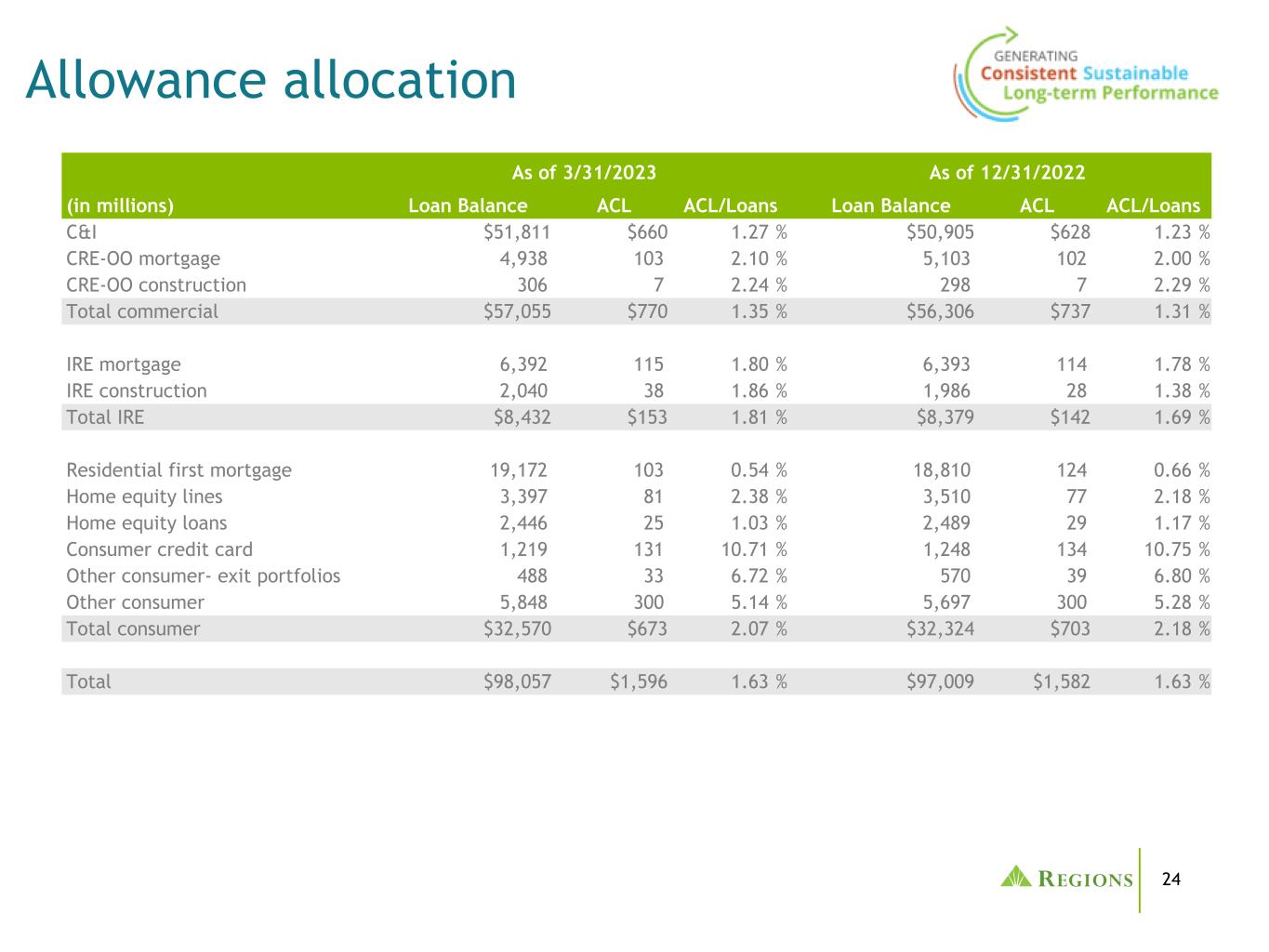
24 As of 3/31/2023 As of 12/31/2022 (in millions) Loan Balance ACL ACL/Loans Loan Balance ACL ACL/Loans C&I $51,811 $660 1.27 % $50,905 $628 1.23 % CRE-OO mortgage 4,938 103 2.10 % 5,103 102 2.00 % CRE-OO construction 306 7 2.24 % 298 7 2.29 % Total commercial $57,055 $770 1.35 % $56,306 $737 1.31 % IRE mortgage 6,392 115 1.80 % 6,393 114 1.78 % IRE construction 2,040 38 1.86 % 1,986 28 1.38 % Total IRE $8,432 $153 1.81 % $8,379 $142 1.69 % Residential first mortgage 19,172 103 0.54 % 18,810 124 0.66 % Home equity lines 3,397 81 2.38 % 3,510 77 2.18 % Home equity loans 2,446 25 1.03 % 2,489 29 1.17 % Consumer credit card 1,219 131 10.71 % 1,248 134 10.75 % Other consumer- exit portfolios 488 33 6.72 % 570 39 6.80 % Other consumer 5,848 300 5.14 % 5,697 300 5.28 % Total consumer $32,570 $673 2.07 % $32,324 $703 2.18 % Total $98,057 $1,596 1.63 % $97,009 $1,582 1.63 % Allowance allocation

25 All Other Commercial 3.6% Investor Real Estate 13.0% Financial Services 10.6% CRE Unsecured, including REITs 10.3% Govt. Education 9.9% Consumer Services 9.0% Technology Services 8.2% Manufacturing 8.1% Energy 2.6% Agriculture 0.5% Utilities 4.7% Business Services 7.6% Distribution 6.6% Healthcare 5.3% Well positioned for next downturn $65.5B Highly Diversified Business Portfolio(1) (1) Balances as of 03/31/23. (2) CRE Unsecured consists 75% of REITs. (2)
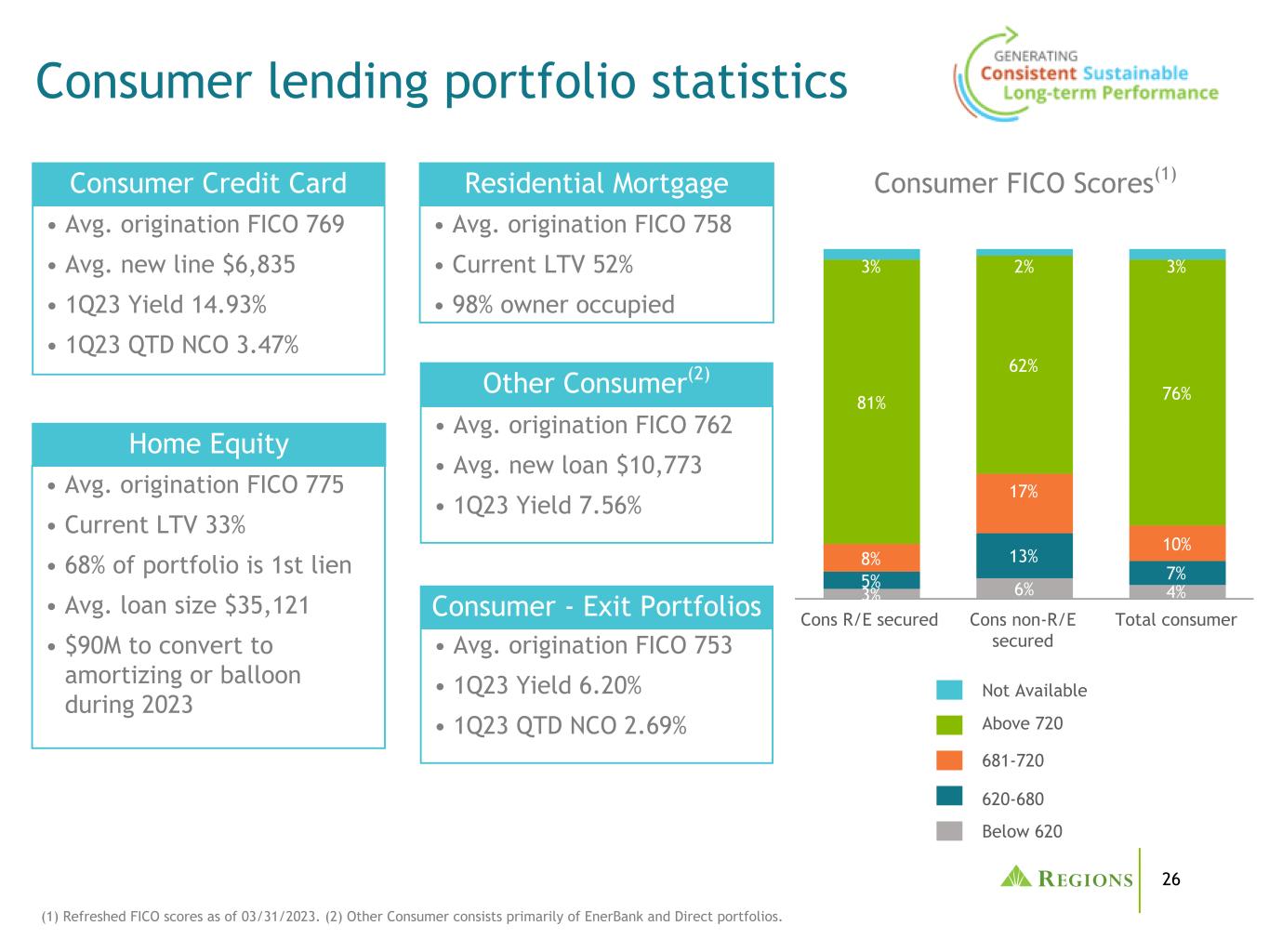
26 Consumer lending portfolio statistics • Avg. origination FICO 758 • Current LTV 52% • 98% owner occupied • Avg. origination FICO 775 • Current LTV 33% • 68% of portfolio is 1st lien • Avg. loan size $35,121 • $90M to convert to amortizing or balloon during 2023 • Avg. origination FICO 762 • Avg. new loan $10,773 • 1Q23 Yield 7.56% • Avg. origination FICO 753 • 1Q23 Yield 6.20% • 1Q23 QTD NCO 2.69% • Avg. origination FICO 769 • Avg. new line $6,835 • 1Q23 Yield 14.93% • 1Q23 QTD NCO 3.47% 3% 6% 4%5% 13% 7% 8% 17% 10% 81% 62% 76% 3% 2% 3% Cons R/E secured Cons non-R/E secured Total consumer Not Available Above 720 620-680 Below 620 681-720 Consumer FICO Scores(1) (1) Refreshed FICO scores as of 03/31/2023. (2) Other Consumer consists primarily of EnerBank and Direct portfolios. Residential Mortgage Consumer - Exit Portfolios Consumer Credit Card Home Equity Other Consumer(2)

27 Environmental, Social & Governance ESG Governance ESG-related elements of the Strategic Plan, annual budget, and capital planning processBOARD OF DIRECTORS Board-Level Committees NCG Committee ESG strategies, initiatives, policies, and practices, along with related voluntary disclosures and stakeholder engagement Risk Committee ESG alignment within Enterprise Risk Appetite Statement, Risk Management Framework, and Risk Library CHR Committee Associate compensation and benefits, corporate culture, DEI practices, talent management, and succession planning Audit Committee Functioning of Company's internal controls and disclosure of material ESG matters Technology Committee Company culture and strategy related to technological and digital innovation Management-Level Committees Executive Leadership Team Evaluates ESG considerations within strategic planning ESG Leadership Council Maintains aggregated view of ESG-related risks and opportunities and provides guidance and direction on internal initiatives; overseen by Executive Leadership Team Disclosure Review Committee Reviews and provides feedback on ESG-related disclosures in SEC reporting and voluntary ESG disclosures Risk Governance Committees Review ESG-related metrics' performance to assess adherence to risk tolerance; supervise enterprise risk assessments incorporating ESG risks O V E R S I G H T E X E C U T I O N A majority of our Directors have identified themselves as having considerable or extensive experience in key ESG areas, including: Corporate Governance Customer Focus & Community Engagement Environmental Sustainability Practices Executive Compensation & Benefits Human Capital Management Suite of ESG Disclosures ■ Annual Review & ESG Report ■ TCFD Report ■ SASB Index ■ GRI Index ■ Workforce Demographics (EEO-1) Index ■ CDP Climate Change Questionnaire Response ■ Community Engagement Report All resources are available through our ESG Resource Center, accessible at ir.regions.com/governance
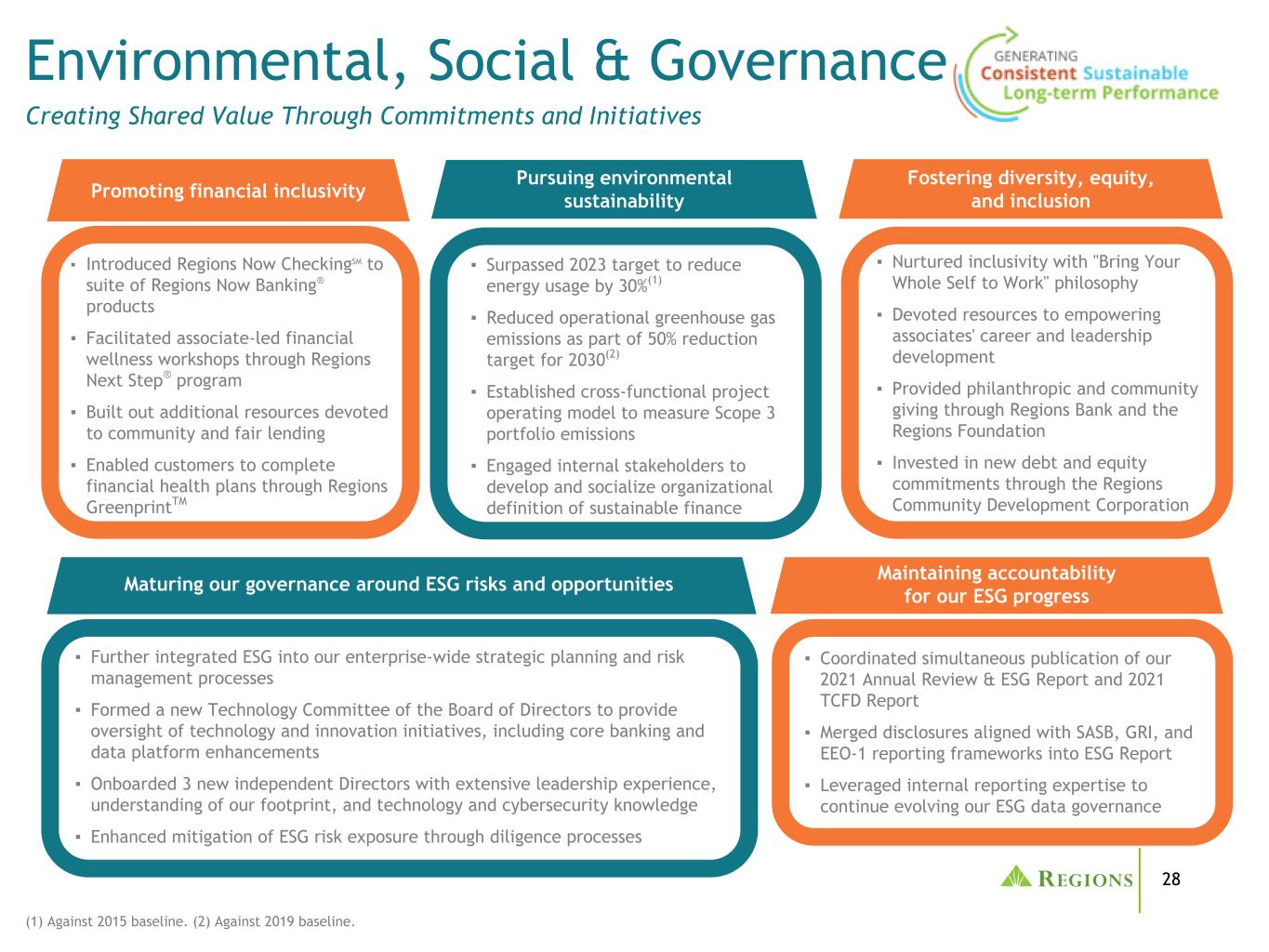
28 Promoting financial inclusivity Pursuing environmental sustainability Maintaining accountability for our ESG progress ▪ Further integrated ESG into our enterprise-wide strategic planning and risk management processes ▪ Formed a new Technology Committee of the Board of Directors to provide oversight of technology and innovation initiatives, including core banking and data platform enhancements ▪ Onboarded 3 new independent Directors with extensive leadership experience, understanding of our footprint, and technology and cybersecurity knowledge ▪ Enhanced mitigation of ESG risk exposure through diligence processes ▪ Introduced Regions Now CheckingSM to suite of Regions Now Banking® products ▪ Facilitated associate-led financial wellness workshops through Regions Next Step® program ▪ Built out additional resources devoted to community and fair lending ▪ Enabled customers to complete financial health plans through Regions GreenprintTM ▪ Surpassed 2023 target to reduce energy usage by 30%(1) ▪ Reduced operational greenhouse gas emissions as part of 50% reduction target for 2030(2) ▪ Established cross-functional project operating model to measure Scope 3 portfolio emissions ▪ Engaged internal stakeholders to develop and socialize organizational definition of sustainable finance ▪ Nurtured inclusivity with "Bring Your Whole Self to Work" philosophy ▪ Devoted resources to empowering associates' career and leadership development ▪ Provided philanthropic and community giving through Regions Bank and the Regions Foundation ▪ Invested in new debt and equity commitments through the Regions Community Development Corporation Fostering diversity, equity, and inclusion Maturing our governance around ESG risks and opportunities ▪ Coordinated simultaneous publication of our 2021 Annual Review & ESG Report and 2021 TCFD Report ▪ Merged disclosures aligned with SASB, GRI, and EEO-1 reporting frameworks into ESG Report ▪ Leveraged internal reporting expertise to continue evolving our ESG data governance Environmental, Social & Governance Creating Shared Value Through Commitments and Initiatives (1) Against 2015 baseline. (2) Against 2019 baseline.

29 Management uses pre-tax pre-provision income (non-GAAP) and adjusted pre-tax pre-provision income (non-GAAP), as well as the adjusted efficiency ratio (non-GAAP) and the adjusted fee income ratio (non-GAAP) to monitor performance and believes these measures provide meaningful information to investors. Non-interest expense (GAAP) is presented excluding certain adjustments to arrive at adjusted non-interest expense (non-GAAP), which is the numerator for the efficiency ratio. Non-interest income (GAAP) is presented excluding certain adjustments to arrive at adjusted non-interest income (non-GAAP), which is the numerator for the fee income ratio. Adjusted non-interest income (non-GAAP) and adjusted non-interest expense (non- GAAP) are used to determine adjusted pre-tax pre-provision income (non-GAAP). Net interest income (GAAP) on a taxable-equivalent basis and non-interest income are added together to arrive at total revenue on a taxable-equivalent basis. Adjustments are made to arrive at adjusted total revenue on a taxable-equivalent basis (non-GAAP), which is the denominator for the fee income and efficiency ratios. Net loan charge-offs (GAAP) are presented excluding adjustments to arrive at adjusted net loan-charge offs (non-GAAP). Adjusted net loan charge-offs as a percentage of average loans (non-GAAP) are calculated as adjusted net loan charge-offs (non-GAAP) divided by average loans (GAAP) and annualized. Regions believes that the exclusion of these adjustments provides a meaningful base for period-to-period comparisons, which management believes will assist investors in analyzing the operating results of the Company and predicting future performance. These non-GAAP financial measures are also used by management to assess the performance of Regions’ business. It is possible that the activities related to the adjustments may recur; however, management does not consider the activities related to the adjustments to be indications of ongoing operations. Regions believes that presentation of these non-GAAP financial measures will permit investors to assess the performance of the Company on the same basis as that applied by management. Tangible common stockholders’ equity and return on average tangible common shareholders' equity (ROATCE) ratios have become a focus of some investors and management believes they may assist investors in analyzing the capital position of the Company absent the effects of intangible assets and preferred stock. Analysts and banking regulators have assessed Regions’ capital adequacy using the tangible common stockholders’ equity measure. Because tangible common stockholders’ equity and ROATCE are not formally defined by GAAP or prescribed in any amount by federal banking regulations they are currently considered to be non-GAAP financial measures and other entities may calculate them differently than Regions’ disclosed calculations. Adjustments to shareholders' equity include intangible assets and related deferred taxes and preferred stock. Additionally, adjustments to ROATCE include accumulated other comprehensive income. Since analysts and banking regulators may assess Regions’ capital adequacy using tangible common stockholders’ equity, management believes that it is useful to provide investors the ability to assess Regions’ capital adequacy on this same basis. Non-GAAP financial measures have inherent limitations, are not required to be uniformly applied and are not audited. Although these non-GAAP financial measures are frequently used by stakeholders in the evaluation of a company, they have limitations as analytical tools, and should not be considered in isolation, or as a substitute for analyses of results as reported under GAAP. In particular, a measure of earnings that excludes selected items does not represent the amount that effectively accrues directly to stockholders. Management and the Board of Directors utilize non-GAAP measures as follows: • Preparation of Regions' operating budgets • Monthly financial performance reporting • Monthly close-out reporting of consolidated results (management only) • Presentation to investors of company performance • Metrics for incentive compensation Non-GAAP information
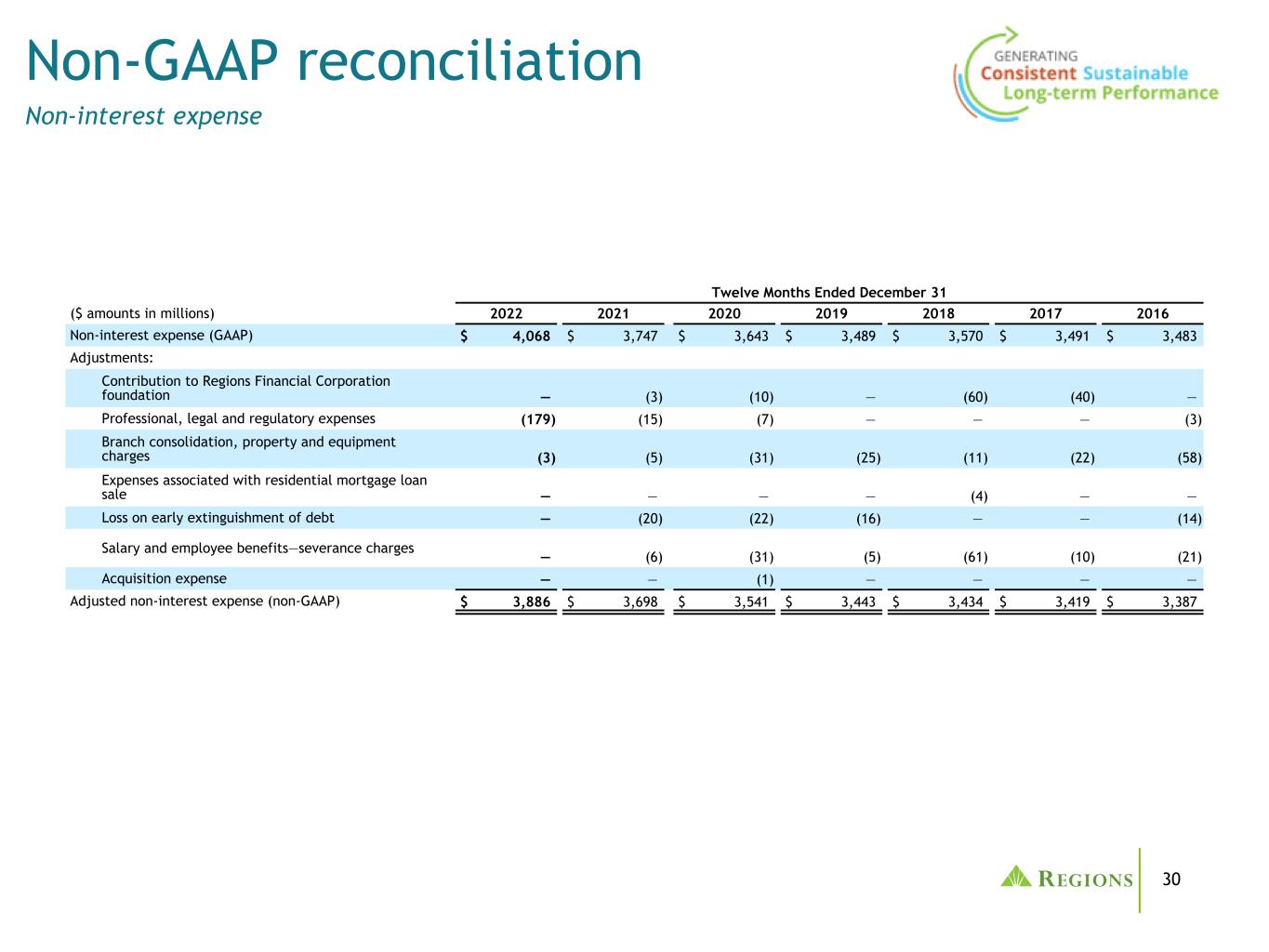
30 Non-GAAP reconciliation Non-interest expense Twelve Months Ended December 31 ($ amounts in millions) 2022 2021 2020 2019 2018 2017 2016 Non-interest expense (GAAP) $ 4,068 $ 3,747 $ 3,643 $ 3,489 $ 3,570 $ 3,491 $ 3,483 Adjustments: Contribution to Regions Financial Corporation foundation — (3) (10) — (60) (40) — Professional, legal and regulatory expenses (179) (15) (7) — — — (3) Branch consolidation, property and equipment charges (3) (5) (31) (25) (11) (22) (58) Expenses associated with residential mortgage loan sale — — — — (4) — — Loss on early extinguishment of debt — (20) (22) (16) — — (14) Salary and employee benefits—severance charges — (6) (31) (5) (61) (10) (21) Acquisition expense — — (1) — — — — Adjusted non-interest expense (non-GAAP) $ 3,886 $ 3,698 $ 3,541 $ 3,443 $ 3,434 $ 3,419 $ 3,387
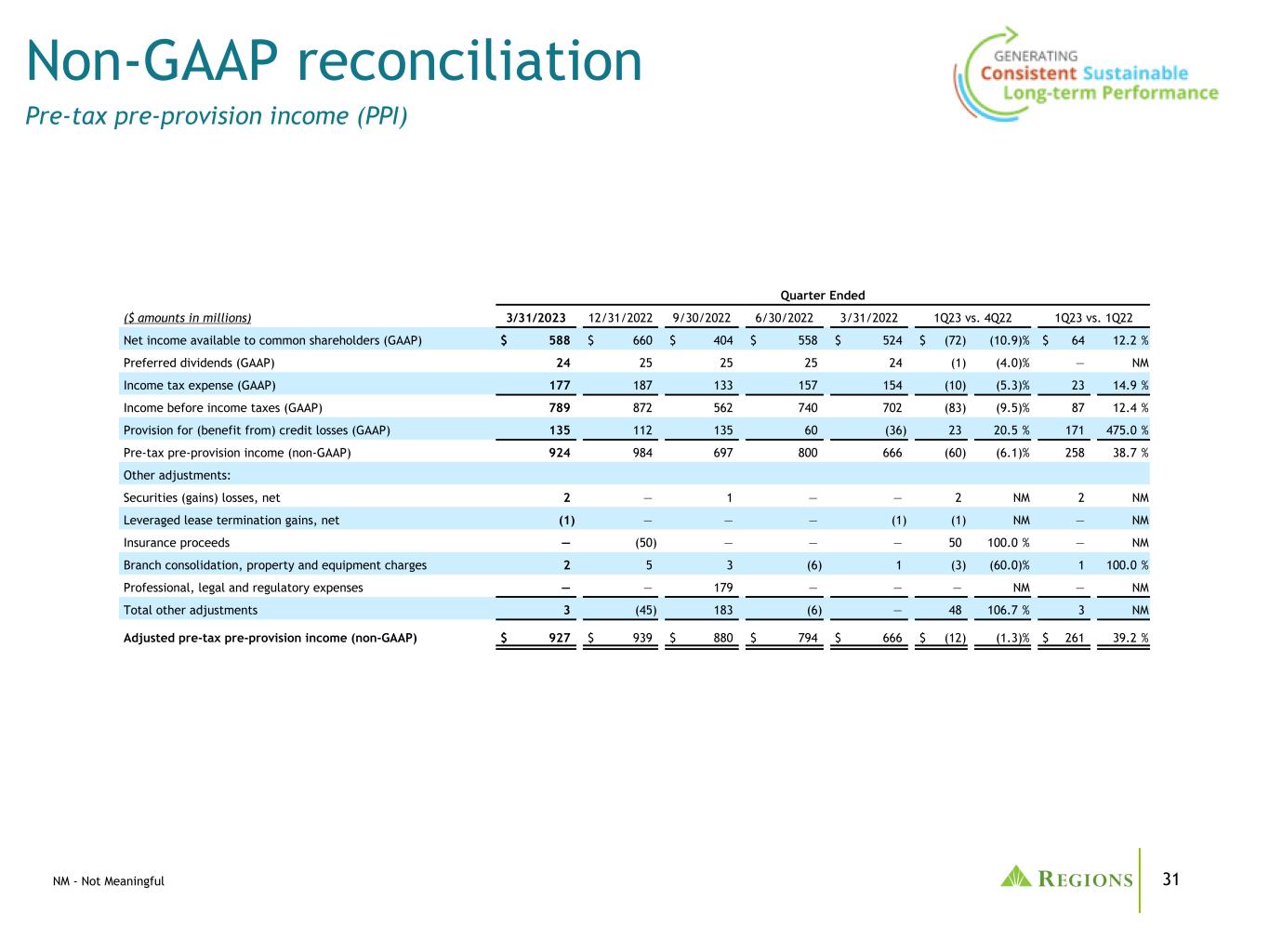
31 Non-GAAP reconciliation Pre-tax pre-provision income (PPI) Quarter Ended ($ amounts in millions) 3/31/2023 12/31/2022 9/30/2022 6/30/2022 3/31/2022 1Q23 vs. 4Q22 1Q23 vs. 1Q22 Net income available to common shareholders (GAAP) $ 588 $ 660 $ 404 $ 558 $ 524 $ (72) (10.9) % $ 64 12.2 % Preferred dividends (GAAP) 24 25 25 25 24 (1) (4.0) % — NM Income tax expense (GAAP) 177 187 133 157 154 (10) (5.3) % 23 14.9 % Income before income taxes (GAAP) 789 872 562 740 702 (83) (9.5) % 87 12.4 % Provision for (benefit from) credit losses (GAAP) 135 112 135 60 (36) 23 20.5 % 171 475.0 % Pre-tax pre-provision income (non-GAAP) 924 984 697 800 666 (60) (6.1) % 258 38.7 % Other adjustments: Securities (gains) losses, net 2 — 1 — — 2 NM 2 NM Leveraged lease termination gains, net (1) — — — (1) (1) NM — NM Insurance proceeds — (50) — — — 50 100.0 % — NM Branch consolidation, property and equipment charges 2 5 3 (6) 1 (3) (60.0) % 1 100.0 % Professional, legal and regulatory expenses — — 179 — — — NM — NM Total other adjustments 3 (45) 183 (6) — 48 106.7 % 3 NM Adjusted pre-tax pre-provision income (non-GAAP) $ 927 $ 939 $ 880 $ 794 $ 666 $ (12) (1.3) % $ 261 39.2 % NM - Not Meaningful
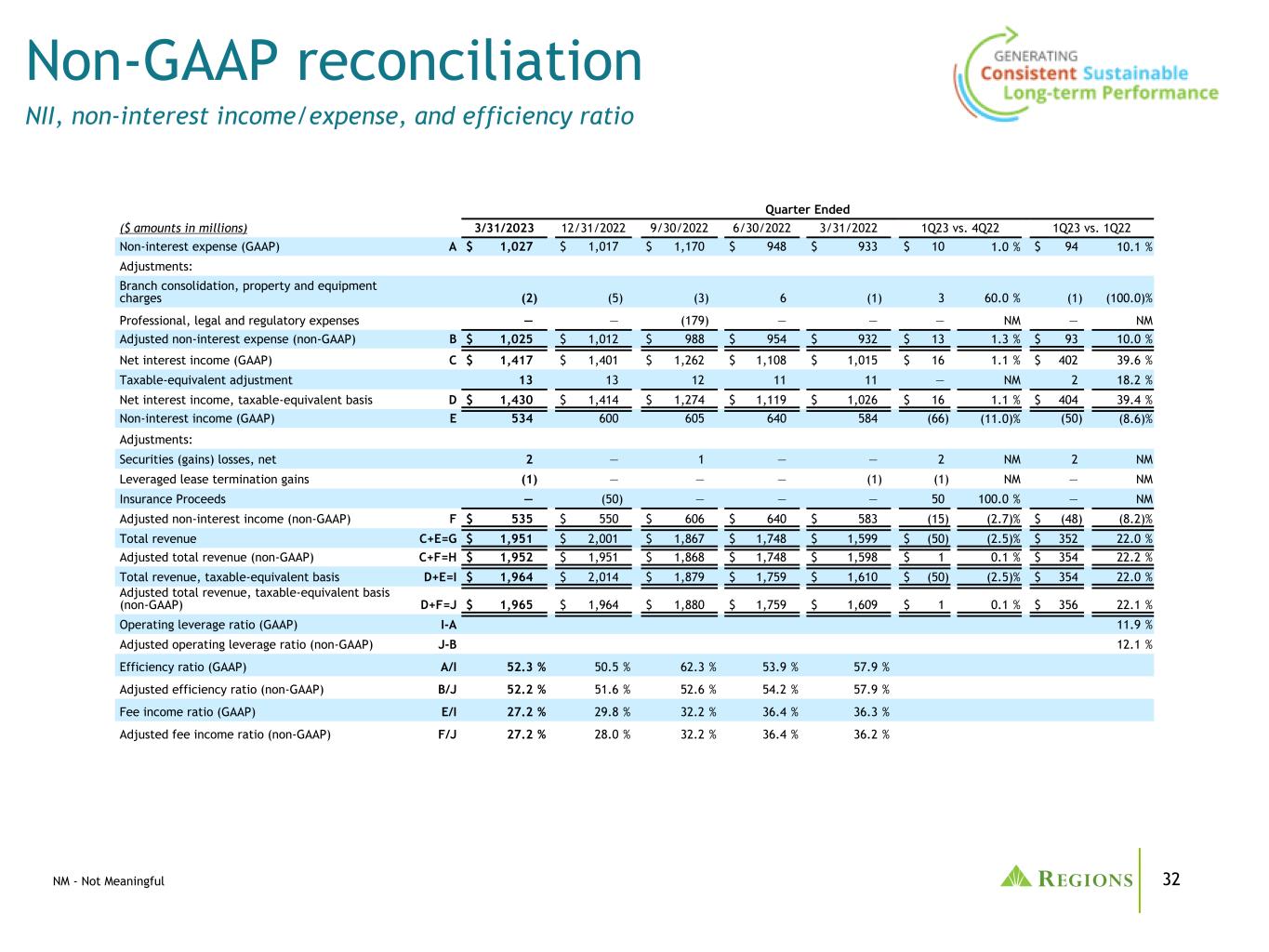
32 Non-GAAP reconciliation NII, non-interest income/expense, and efficiency ratio NM - Not Meaningful Quarter Ended ($ amounts in millions) 3/31/2023 12/31/2022 9/30/2022 6/30/2022 3/31/2022 1Q23 vs. 4Q22 1Q23 vs. 1Q22 Non-interest expense (GAAP) A $ 1,027 $ 1,017 $ 1,170 $ 948 $ 933 $ 10 1.0 % $ 94 10.1 % Adjustments: Branch consolidation, property and equipment charges (2) (5) (3) 6 (1) 3 60.0 % (1) (100.0) % Professional, legal and regulatory expenses — — (179) — — — NM — NM Adjusted non-interest expense (non-GAAP) B $ 1,025 $ 1,012 $ 988 $ 954 $ 932 $ 13 1.3 % $ 93 10.0 % Net interest income (GAAP) C $ 1,417 $ 1,401 $ 1,262 $ 1,108 $ 1,015 $ 16 1.1 % $ 402 39.6 % Taxable-equivalent adjustment 13 13 12 11 11 — NM 2 18.2 % Net interest income, taxable-equivalent basis D $ 1,430 $ 1,414 $ 1,274 $ 1,119 $ 1,026 $ 16 1.1 % $ 404 39.4 % Non-interest income (GAAP) E 534 600 605 640 584 (66) (11.0) % (50) (8.6) % Adjustments: Securities (gains) losses, net 2 — 1 — — 2 NM 2 NM Leveraged lease termination gains (1) — — — (1) (1) NM — NM Insurance Proceeds — (50) — — — 50 100.0 % — NM Adjusted non-interest income (non-GAAP) F $ 535 $ 550 $ 606 $ 640 $ 583 (15) (2.7) % $ (48) (8.2) % Total revenue C+E=G $ 1,951 $ 2,001 $ 1,867 $ 1,748 $ 1,599 $ (50) (2.5) % $ 352 22.0 % Adjusted total revenue (non-GAAP) C+F=H $ 1,952 $ 1,951 $ 1,868 $ 1,748 $ 1,598 $ 1 0.1 % $ 354 22.2 % Total revenue, taxable-equivalent basis D+E=I $ 1,964 $ 2,014 $ 1,879 $ 1,759 $ 1,610 $ (50) (2.5) % $ 354 22.0 % Adjusted total revenue, taxable-equivalent basis (non-GAAP) D+F=J $ 1,965 $ 1,964 $ 1,880 $ 1,759 $ 1,609 $ 1 0.1 % $ 356 22.1 % Operating leverage ratio (GAAP) I-A 11.9 % Adjusted operating leverage ratio (non-GAAP) J-B 12.1 % Efficiency ratio (GAAP) A/I 52.3 % 50.5 % 62.3 % 53.9 % 57.9 % Adjusted efficiency ratio (non-GAAP) B/J 52.2 % 51.6 % 52.6 % 54.2 % 57.9 % Fee income ratio (GAAP) E/I 27.2 % 29.8 % 32.2 % 36.4 % 36.3 % Adjusted fee income ratio (non-GAAP) F/J 27.2 % 28.0 % 32.2 % 36.4 % 36.2 %
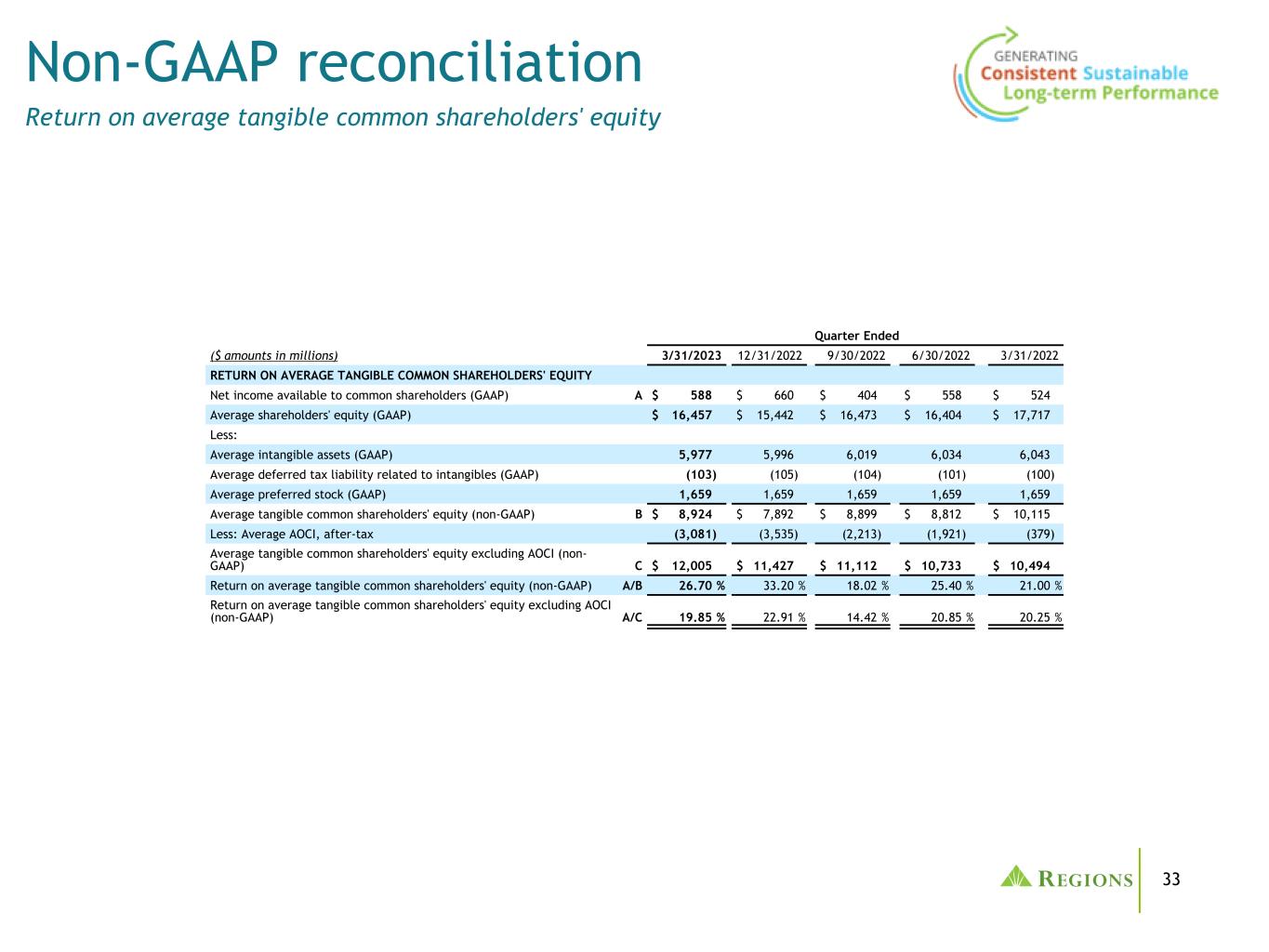
33 Quarter Ended ($ amounts in millions) 3/31/2023 12/31/2022 9/30/2022 6/30/2022 3/31/2022 RETURN ON AVERAGE TANGIBLE COMMON SHAREHOLDERS' EQUITY Net income available to common shareholders (GAAP) A $ 588 $ 660 $ 404 $ 558 $ 524 Average shareholders' equity (GAAP) $ 16,457 $ 15,442 $ 16,473 $ 16,404 $ 17,717 Less: Average intangible assets (GAAP) 5,977 5,996 6,019 6,034 6,043 Average deferred tax liability related to intangibles (GAAP) (103) (105) (104) (101) (100) Average preferred stock (GAAP) 1,659 1,659 1,659 1,659 1,659 Average tangible common shareholders' equity (non-GAAP) B $ 8,924 $ 7,892 $ 8,899 $ 8,812 $ 10,115 Less: Average AOCI, after-tax (3,081) (3,535) (2,213) (1,921) (379) Average tangible common shareholders' equity excluding AOCI (non- GAAP) C $ 12,005 $ 11,427 $ 11,112 $ 10,733 $ 10,494 Return on average tangible common shareholders' equity (non-GAAP) A/B 26.70 % 33.20 % 18.02 % 25.40 % 21.00 % Return on average tangible common shareholders' equity excluding AOCI (non-GAAP) A/C 19.85 % 22.91 % 14.42 % 20.85 % 20.25 % Non-GAAP reconciliation Return on average tangible common shareholders' equity
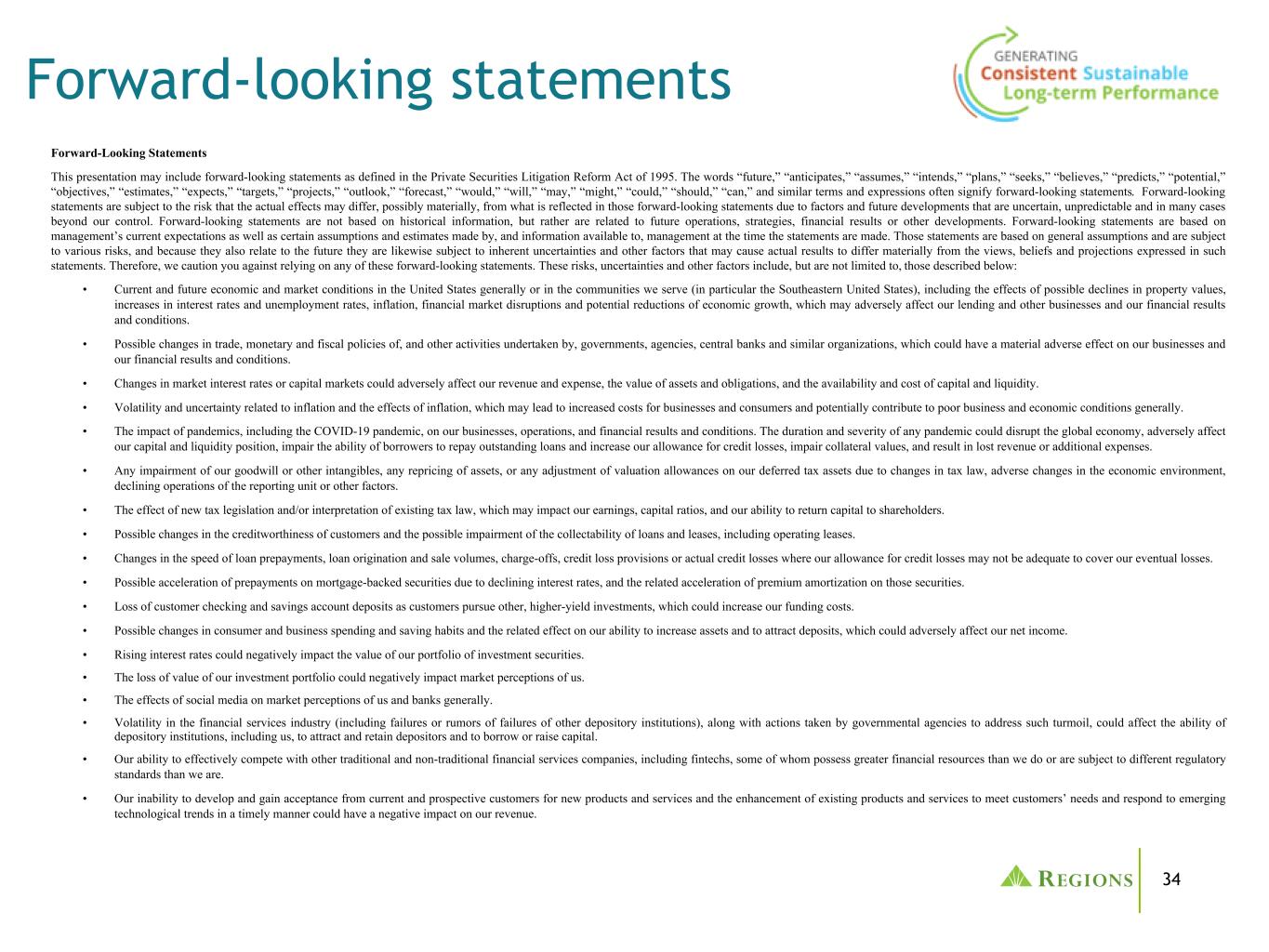
34 Forward-Looking Statements This presentation may include forward-looking statements as defined in the Private Securities Litigation Reform Act of 1995. The words “future,” “anticipates,” “assumes,” “intends,” “plans,” “seeks,” “believes,” “predicts,” “potential,” “objectives,” “estimates,” “expects,” “targets,” “projects,” “outlook,” “forecast,” “would,” “will,” “may,” “might,” “could,” “should,” “can,” and similar terms and expressions often signify forward-looking statements. Forward-looking statements are subject to the risk that the actual effects may differ, possibly materially, from what is reflected in those forward-looking statements due to factors and future developments that are uncertain, unpredictable and in many cases beyond our control. Forward-looking statements are not based on historical information, but rather are related to future operations, strategies, financial results or other developments. Forward-looking statements are based on management’s current expectations as well as certain assumptions and estimates made by, and information available to, management at the time the statements are made. Those statements are based on general assumptions and are subject to various risks, and because they also relate to the future they are likewise subject to inherent uncertainties and other factors that may cause actual results to differ materially from the views, beliefs and projections expressed in such statements. Therefore, we caution you against relying on any of these forward-looking statements. These risks, uncertainties and other factors include, but are not limited to, those described below: • Current and future economic and market conditions in the United States generally or in the communities we serve (in particular the Southeastern United States), including the effects of possible declines in property values, increases in interest rates and unemployment rates, inflation, financial market disruptions and potential reductions of economic growth, which may adversely affect our lending and other businesses and our financial results and conditions. • Possible changes in trade, monetary and fiscal policies of, and other activities undertaken by, governments, agencies, central banks and similar organizations, which could have a material adverse effect on our businesses and our financial results and conditions. • Changes in market interest rates or capital markets could adversely affect our revenue and expense, the value of assets and obligations, and the availability and cost of capital and liquidity. • Volatility and uncertainty related to inflation and the effects of inflation, which may lead to increased costs for businesses and consumers and potentially contribute to poor business and economic conditions generally. • The impact of pandemics, including the COVID-19 pandemic, on our businesses, operations, and financial results and conditions. The duration and severity of any pandemic could disrupt the global economy, adversely affect our capital and liquidity position, impair the ability of borrowers to repay outstanding loans and increase our allowance for credit losses, impair collateral values, and result in lost revenue or additional expenses. • Any impairment of our goodwill or other intangibles, any repricing of assets, or any adjustment of valuation allowances on our deferred tax assets due to changes in tax law, adverse changes in the economic environment, declining operations of the reporting unit or other factors. • The effect of new tax legislation and/or interpretation of existing tax law, which may impact our earnings, capital ratios, and our ability to return capital to shareholders. • Possible changes in the creditworthiness of customers and the possible impairment of the collectability of loans and leases, including operating leases. • Changes in the speed of loan prepayments, loan origination and sale volumes, charge-offs, credit loss provisions or actual credit losses where our allowance for credit losses may not be adequate to cover our eventual losses. • Possible acceleration of prepayments on mortgage-backed securities due to declining interest rates, and the related acceleration of premium amortization on those securities. • Loss of customer checking and savings account deposits as customers pursue other, higher-yield investments, which could increase our funding costs. • Possible changes in consumer and business spending and saving habits and the related effect on our ability to increase assets and to attract deposits, which could adversely affect our net income. • Rising interest rates could negatively impact the value of our portfolio of investment securities. • The loss of value of our investment portfolio could negatively impact market perceptions of us. • The effects of social media on market perceptions of us and banks generally. • Volatility in the financial services industry (including failures or rumors of failures of other depository institutions), along with actions taken by governmental agencies to address such turmoil, could affect the ability of depository institutions, including us, to attract and retain depositors and to borrow or raise capital. • Our ability to effectively compete with other traditional and non-traditional financial services companies, including fintechs, some of whom possess greater financial resources than we do or are subject to different regulatory standards than we are. • Our inability to develop and gain acceptance from current and prospective customers for new products and services and the enhancement of existing products and services to meet customers’ needs and respond to emerging technological trends in a timely manner could have a negative impact on our revenue. Forward-looking statements
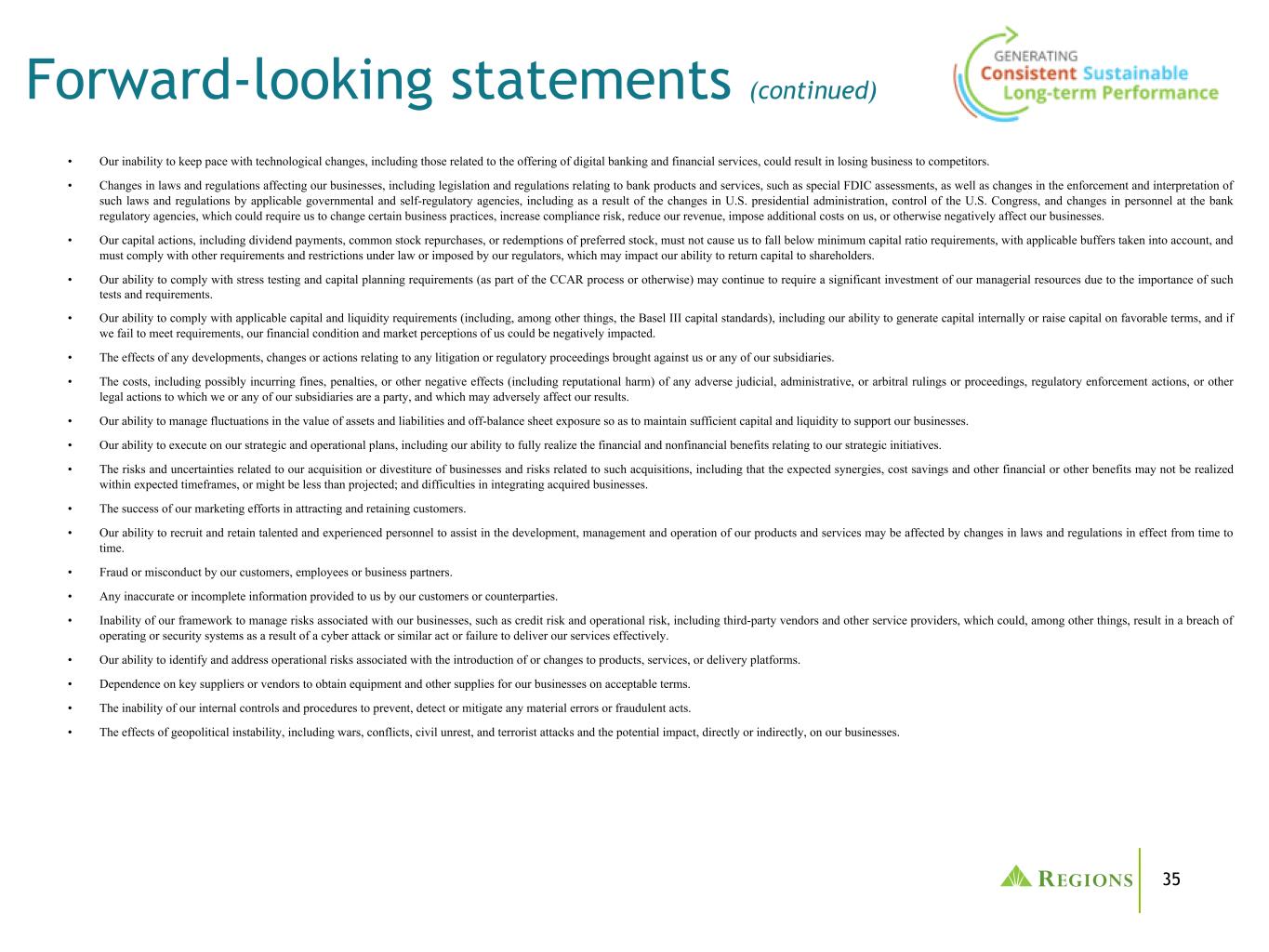
35 • Our inability to keep pace with technological changes, including those related to the offering of digital banking and financial services, could result in losing business to competitors. • Changes in laws and regulations affecting our businesses, including legislation and regulations relating to bank products and services, such as special FDIC assessments, as well as changes in the enforcement and interpretation of such laws and regulations by applicable governmental and self-regulatory agencies, including as a result of the changes in U.S. presidential administration, control of the U.S. Congress, and changes in personnel at the bank regulatory agencies, which could require us to change certain business practices, increase compliance risk, reduce our revenue, impose additional costs on us, or otherwise negatively affect our businesses. • Our capital actions, including dividend payments, common stock repurchases, or redemptions of preferred stock, must not cause us to fall below minimum capital ratio requirements, with applicable buffers taken into account, and must comply with other requirements and restrictions under law or imposed by our regulators, which may impact our ability to return capital to shareholders. • Our ability to comply with stress testing and capital planning requirements (as part of the CCAR process or otherwise) may continue to require a significant investment of our managerial resources due to the importance of such tests and requirements. • Our ability to comply with applicable capital and liquidity requirements (including, among other things, the Basel III capital standards), including our ability to generate capital internally or raise capital on favorable terms, and if we fail to meet requirements, our financial condition and market perceptions of us could be negatively impacted. • The effects of any developments, changes or actions relating to any litigation or regulatory proceedings brought against us or any of our subsidiaries. • The costs, including possibly incurring fines, penalties, or other negative effects (including reputational harm) of any adverse judicial, administrative, or arbitral rulings or proceedings, regulatory enforcement actions, or other legal actions to which we or any of our subsidiaries are a party, and which may adversely affect our results. • Our ability to manage fluctuations in the value of assets and liabilities and off-balance sheet exposure so as to maintain sufficient capital and liquidity to support our businesses. • Our ability to execute on our strategic and operational plans, including our ability to fully realize the financial and nonfinancial benefits relating to our strategic initiatives. • The risks and uncertainties related to our acquisition or divestiture of businesses and risks related to such acquisitions, including that the expected synergies, cost savings and other financial or other benefits may not be realized within expected timeframes, or might be less than projected; and difficulties in integrating acquired businesses. • The success of our marketing efforts in attracting and retaining customers. • Our ability to recruit and retain talented and experienced personnel to assist in the development, management and operation of our products and services may be affected by changes in laws and regulations in effect from time to time. • Fraud or misconduct by our customers, employees or business partners. • Any inaccurate or incomplete information provided to us by our customers or counterparties. • Inability of our framework to manage risks associated with our businesses, such as credit risk and operational risk, including third-party vendors and other service providers, which could, among other things, result in a breach of operating or security systems as a result of a cyber attack or similar act or failure to deliver our services effectively. • Our ability to identify and address operational risks associated with the introduction of or changes to products, services, or delivery platforms. • Dependence on key suppliers or vendors to obtain equipment and other supplies for our businesses on acceptable terms. • The inability of our internal controls and procedures to prevent, detect or mitigate any material errors or fraudulent acts. • The effects of geopolitical instability, including wars, conflicts, civil unrest, and terrorist attacks and the potential impact, directly or indirectly, on our businesses. Forward-looking statements (continued)
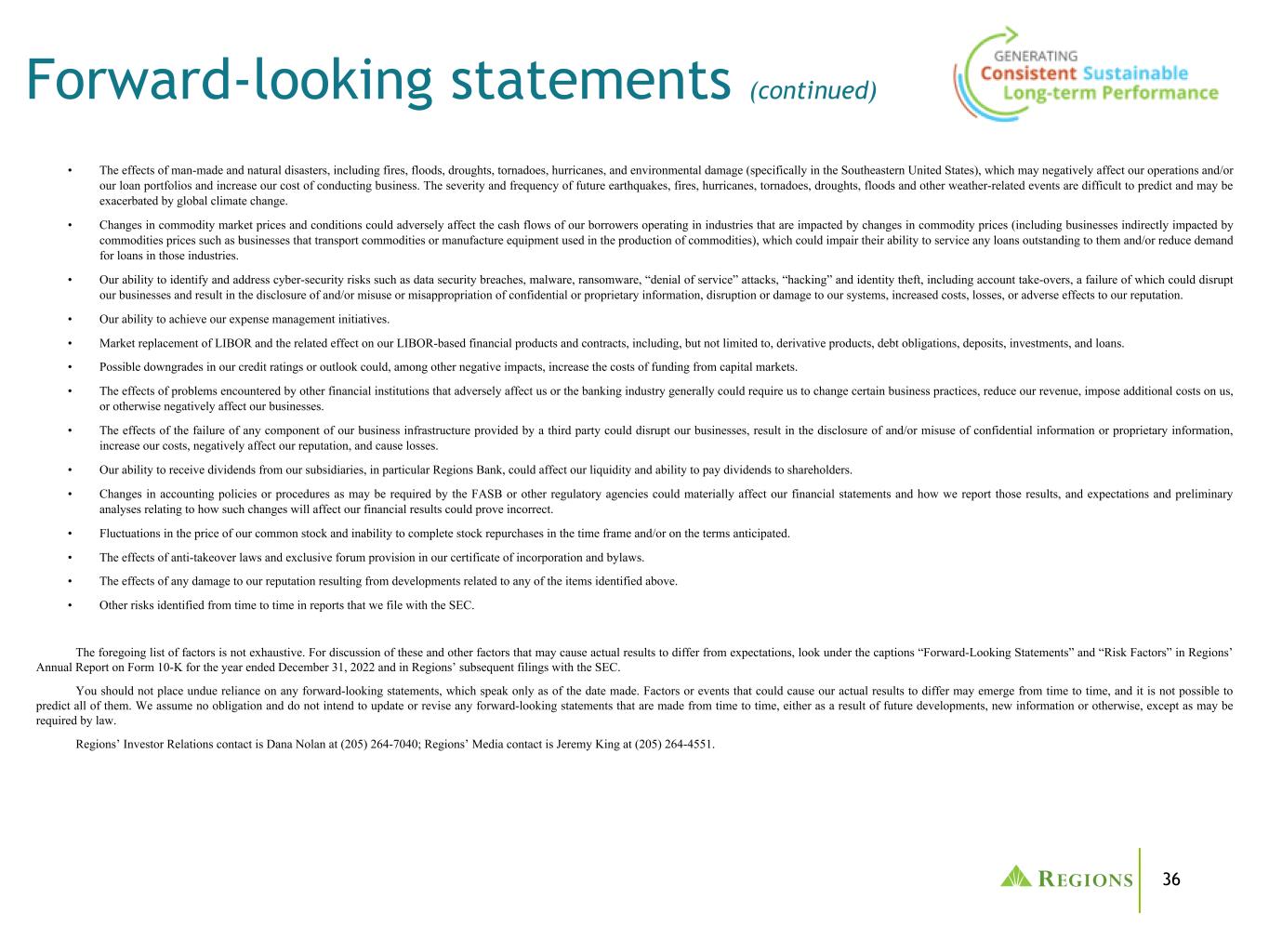
36 • The effects of man-made and natural disasters, including fires, floods, droughts, tornadoes, hurricanes, and environmental damage (specifically in the Southeastern United States), which may negatively affect our operations and/or our loan portfolios and increase our cost of conducting business. The severity and frequency of future earthquakes, fires, hurricanes, tornadoes, droughts, floods and other weather-related events are difficult to predict and may be exacerbated by global climate change. • Changes in commodity market prices and conditions could adversely affect the cash flows of our borrowers operating in industries that are impacted by changes in commodity prices (including businesses indirectly impacted by commodities prices such as businesses that transport commodities or manufacture equipment used in the production of commodities), which could impair their ability to service any loans outstanding to them and/or reduce demand for loans in those industries. • Our ability to identify and address cyber-security risks such as data security breaches, malware, ransomware, “denial of service” attacks, “hacking” and identity theft, including account take-overs, a failure of which could disrupt our businesses and result in the disclosure of and/or misuse or misappropriation of confidential or proprietary information, disruption or damage to our systems, increased costs, losses, or adverse effects to our reputation. • Our ability to achieve our expense management initiatives. • Market replacement of LIBOR and the related effect on our LIBOR-based financial products and contracts, including, but not limited to, derivative products, debt obligations, deposits, investments, and loans. • Possible downgrades in our credit ratings or outlook could, among other negative impacts, increase the costs of funding from capital markets. • The effects of problems encountered by other financial institutions that adversely affect us or the banking industry generally could require us to change certain business practices, reduce our revenue, impose additional costs on us, or otherwise negatively affect our businesses. • The effects of the failure of any component of our business infrastructure provided by a third party could disrupt our businesses, result in the disclosure of and/or misuse of confidential information or proprietary information, increase our costs, negatively affect our reputation, and cause losses. • Our ability to receive dividends from our subsidiaries, in particular Regions Bank, could affect our liquidity and ability to pay dividends to shareholders. • Changes in accounting policies or procedures as may be required by the FASB or other regulatory agencies could materially affect our financial statements and how we report those results, and expectations and preliminary analyses relating to how such changes will affect our financial results could prove incorrect. • Fluctuations in the price of our common stock and inability to complete stock repurchases in the time frame and/or on the terms anticipated. • The effects of anti-takeover laws and exclusive forum provision in our certificate of incorporation and bylaws. • The effects of any damage to our reputation resulting from developments related to any of the items identified above. • Other risks identified from time to time in reports that we file with the SEC. The foregoing list of factors is not exhaustive. For discussion of these and other factors that may cause actual results to differ from expectations, look under the captions “Forward-Looking Statements” and “Risk Factors” in Regions’ Annual Report on Form 10-K for the year ended December 31, 2022 and in Regions’ subsequent filings with the SEC. You should not place undue reliance on any forward-looking statements, which speak only as of the date made. Factors or events that could cause our actual results to differ may emerge from time to time, and it is not possible to predict all of them. We assume no obligation and do not intend to update or revise any forward-looking statements that are made from time to time, either as a result of future developments, new information or otherwise, except as may be required by law. Regions’ Investor Relations contact is Dana Nolan at (205) 264-7040; Regions’ Media contact is Jeremy King at (205) 264-4551. Forward-looking statements (continued)

37 ®




































